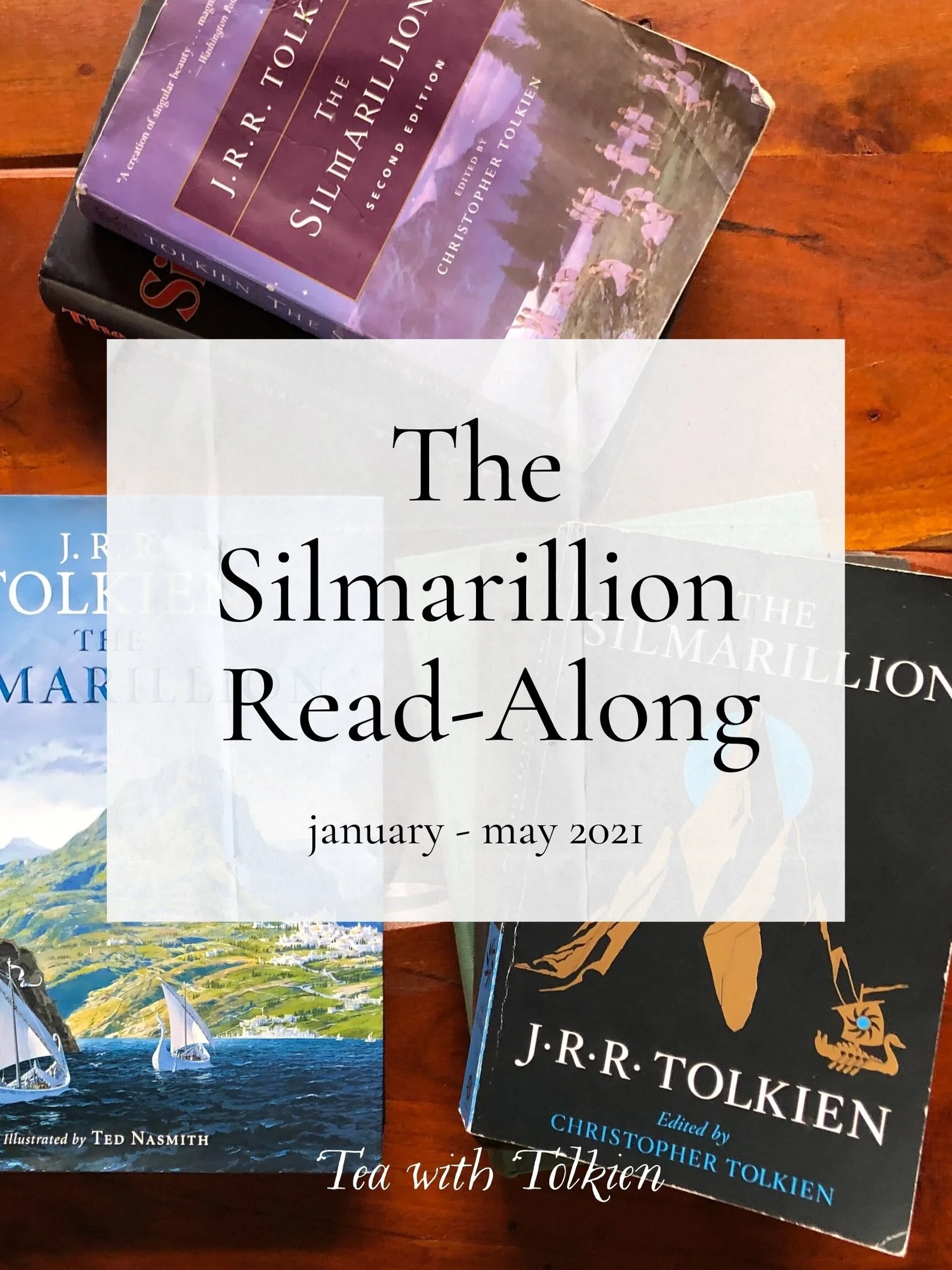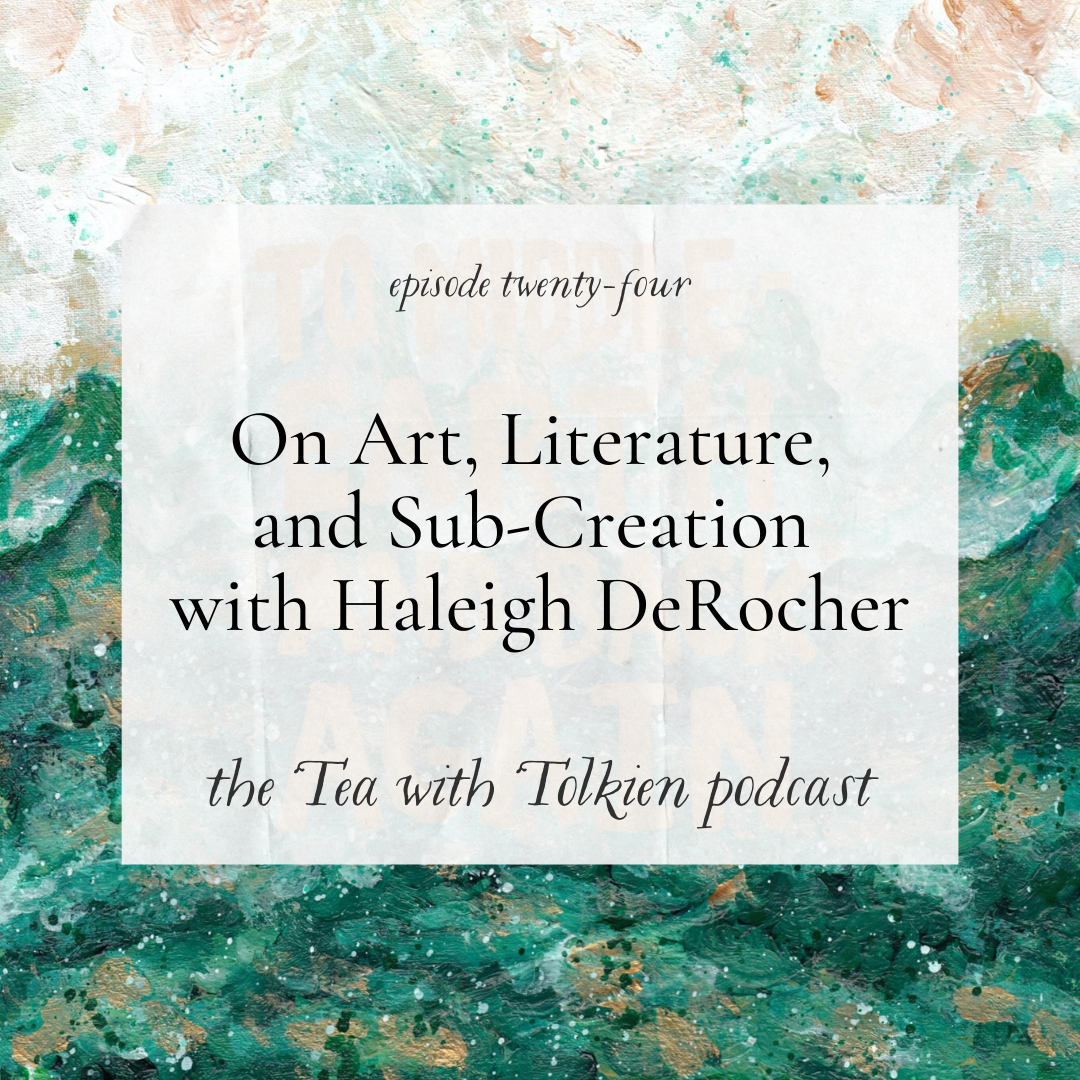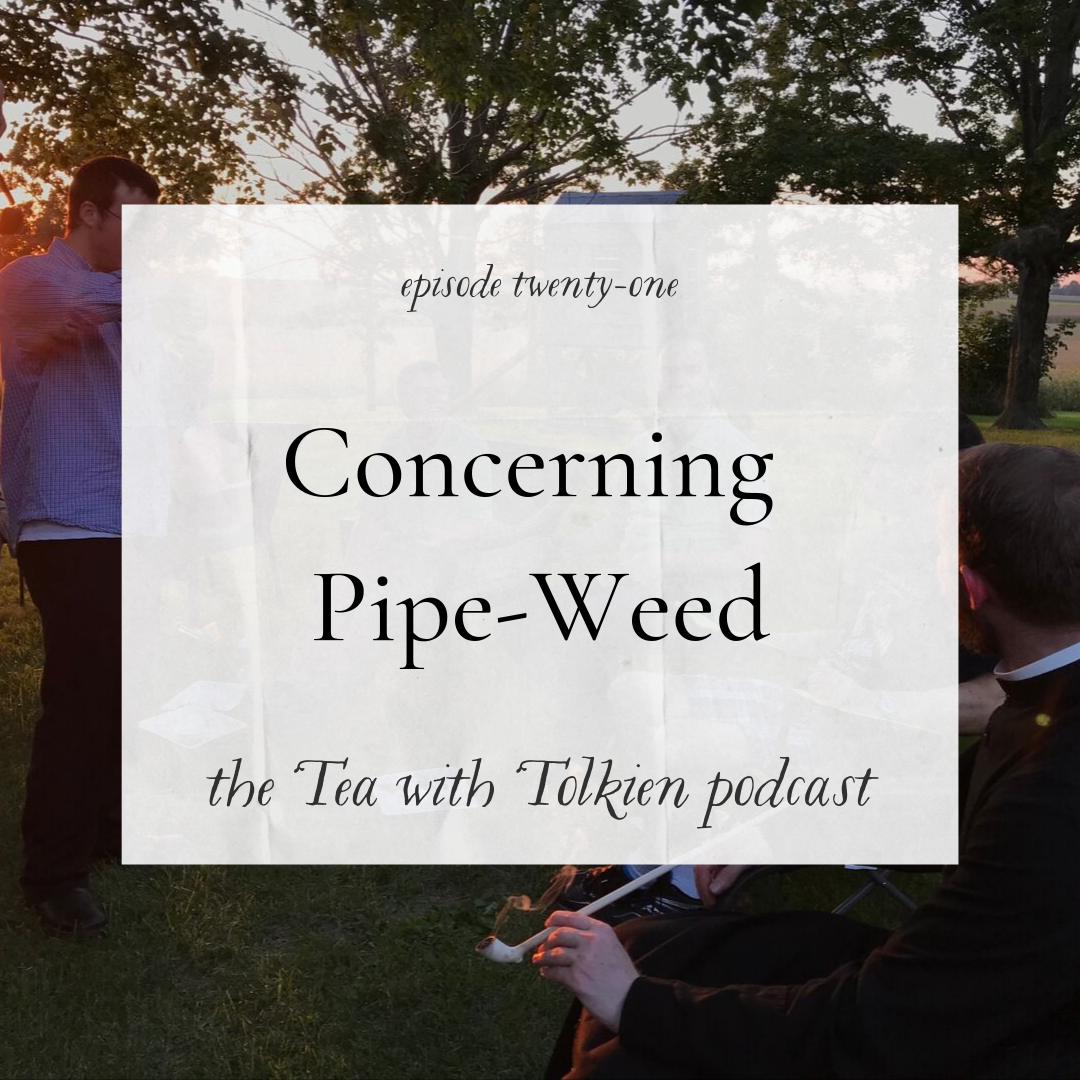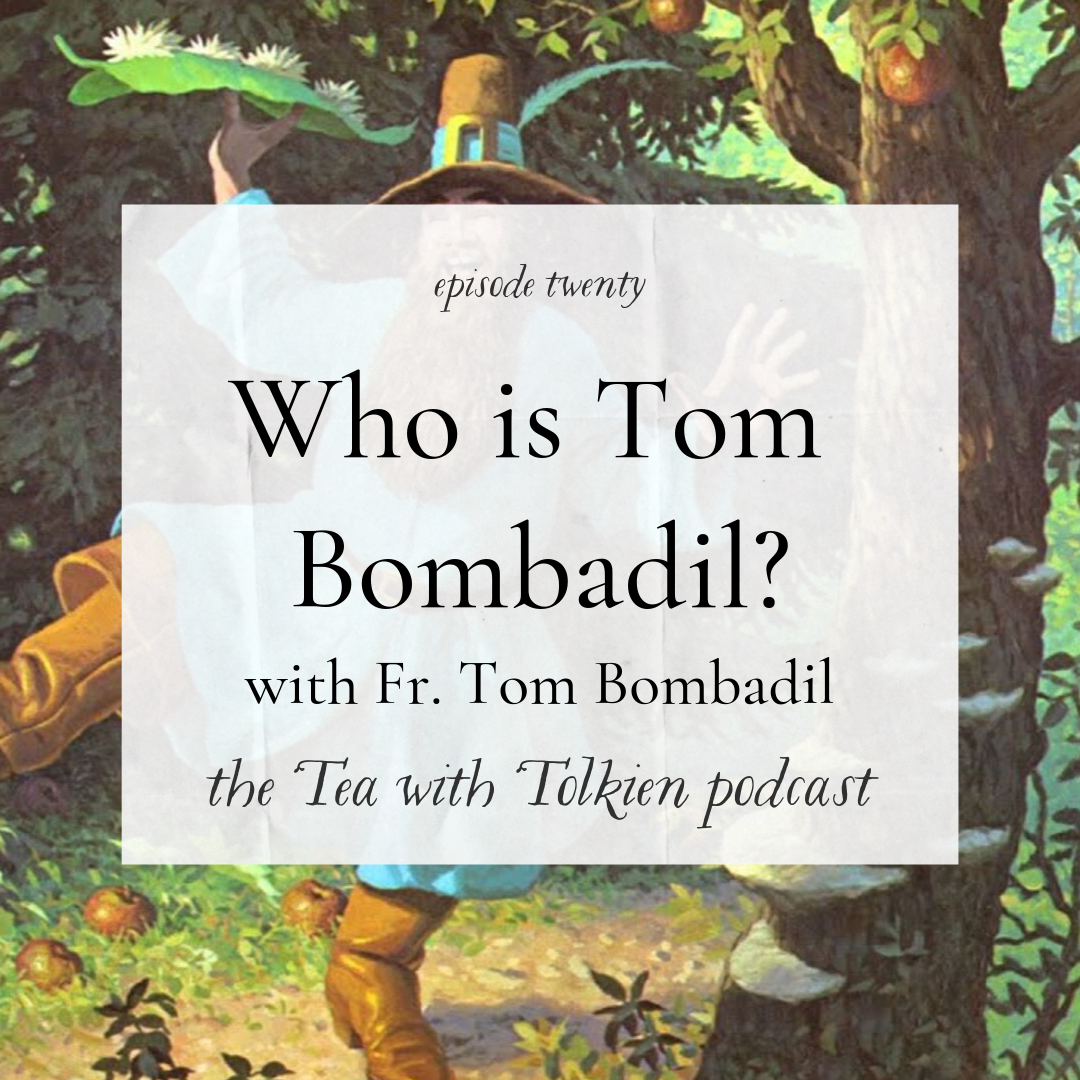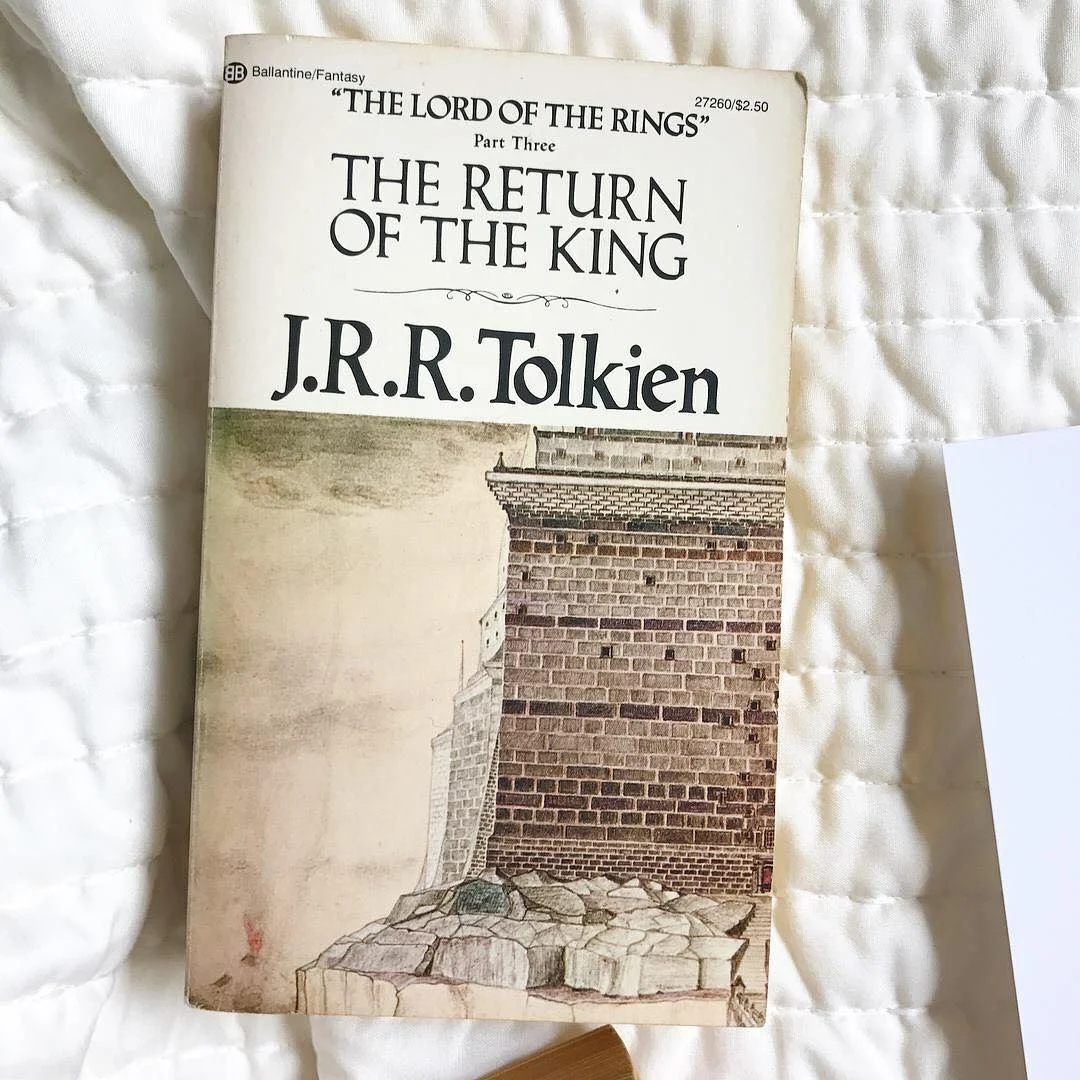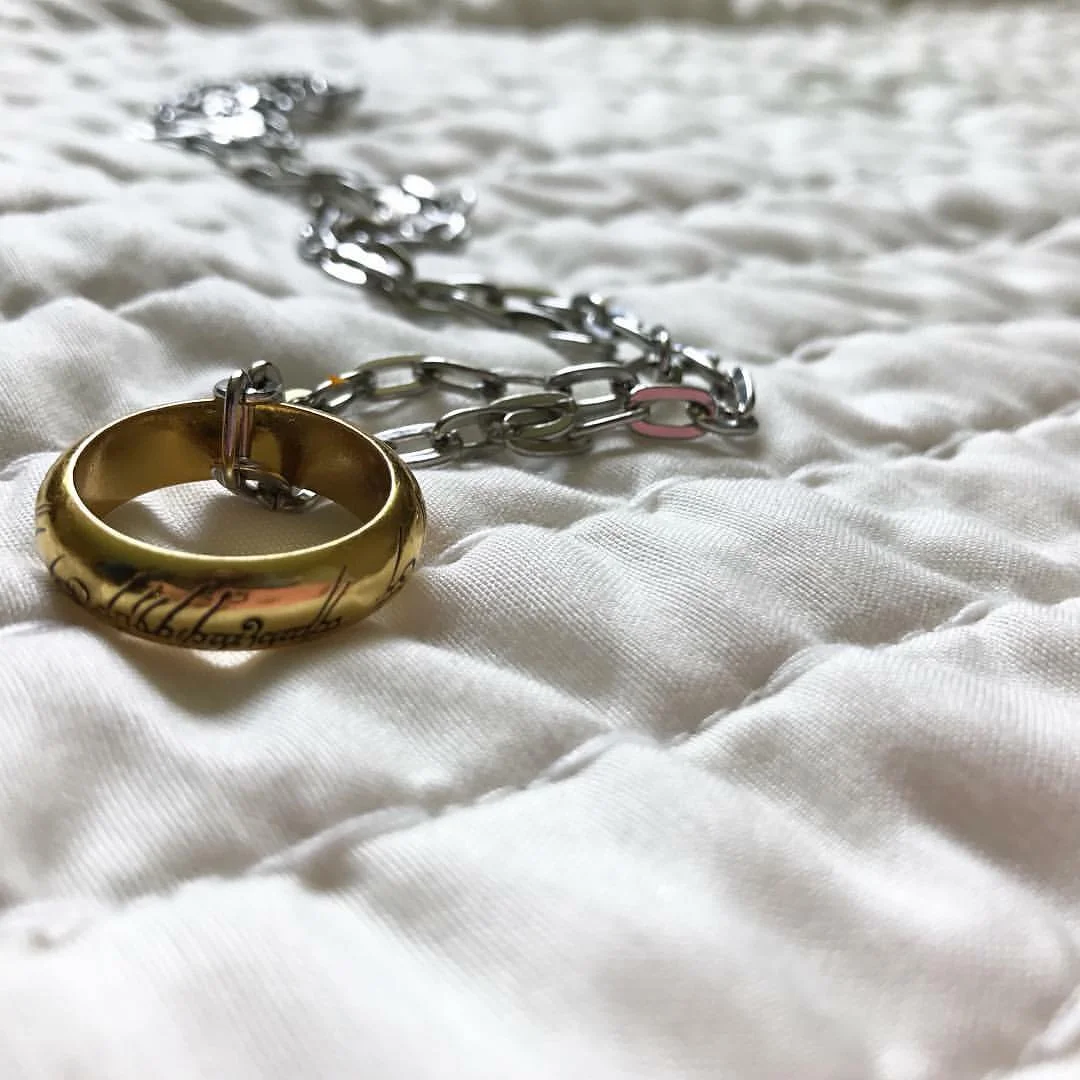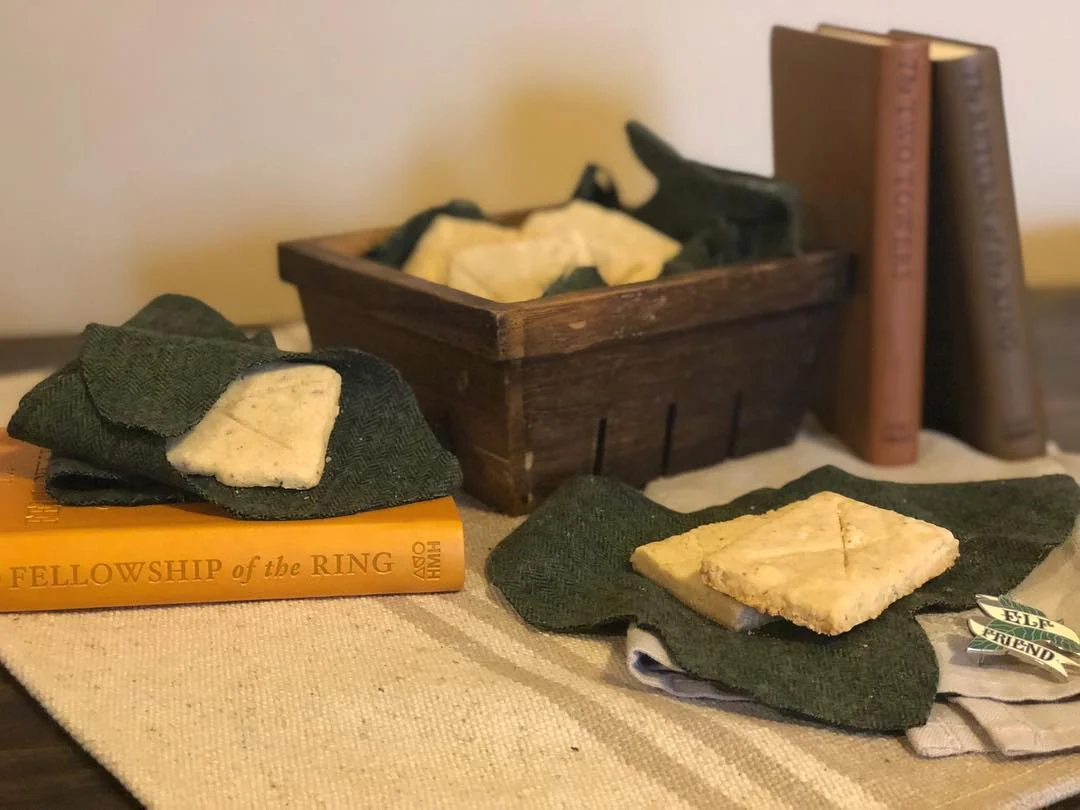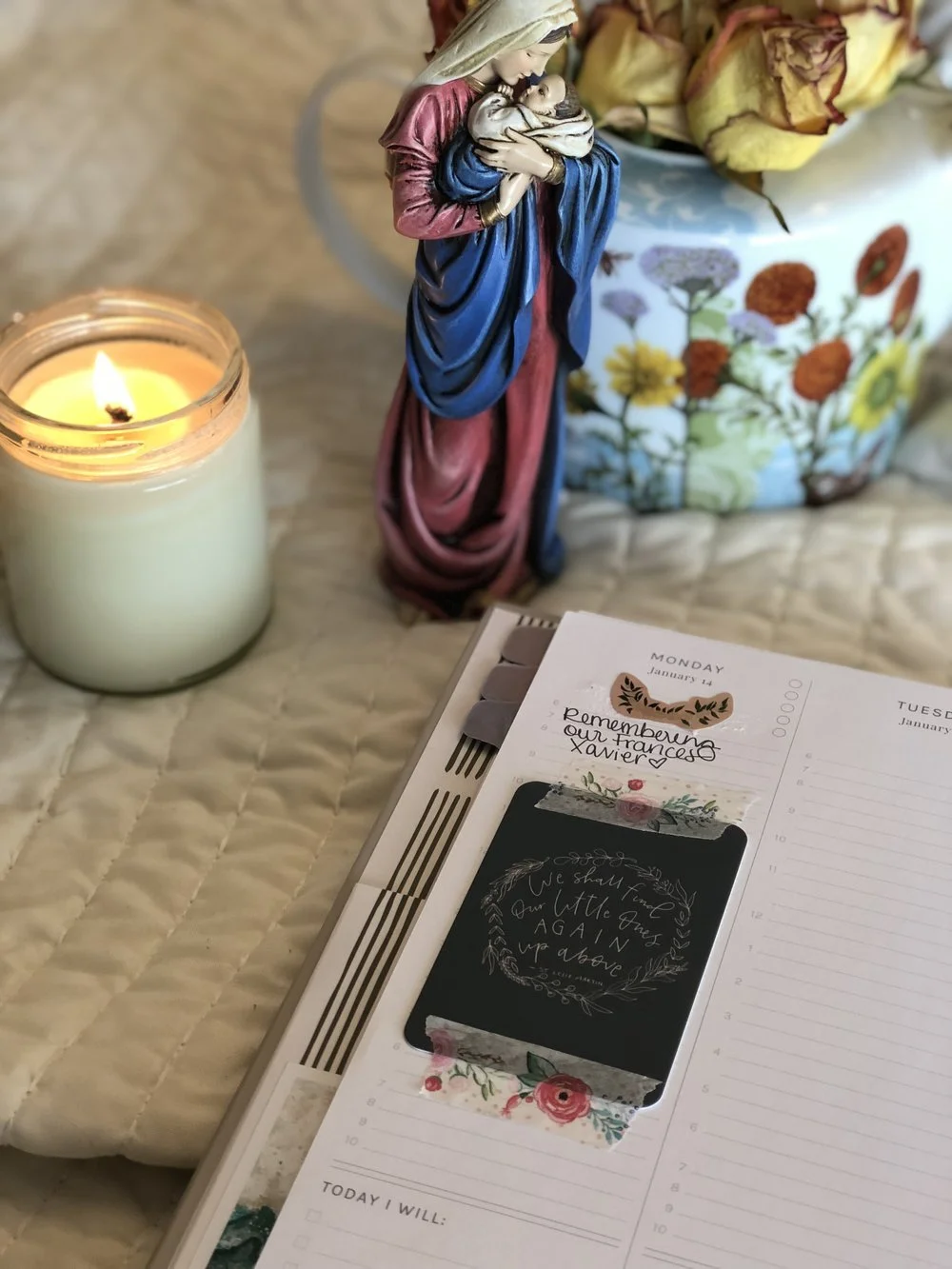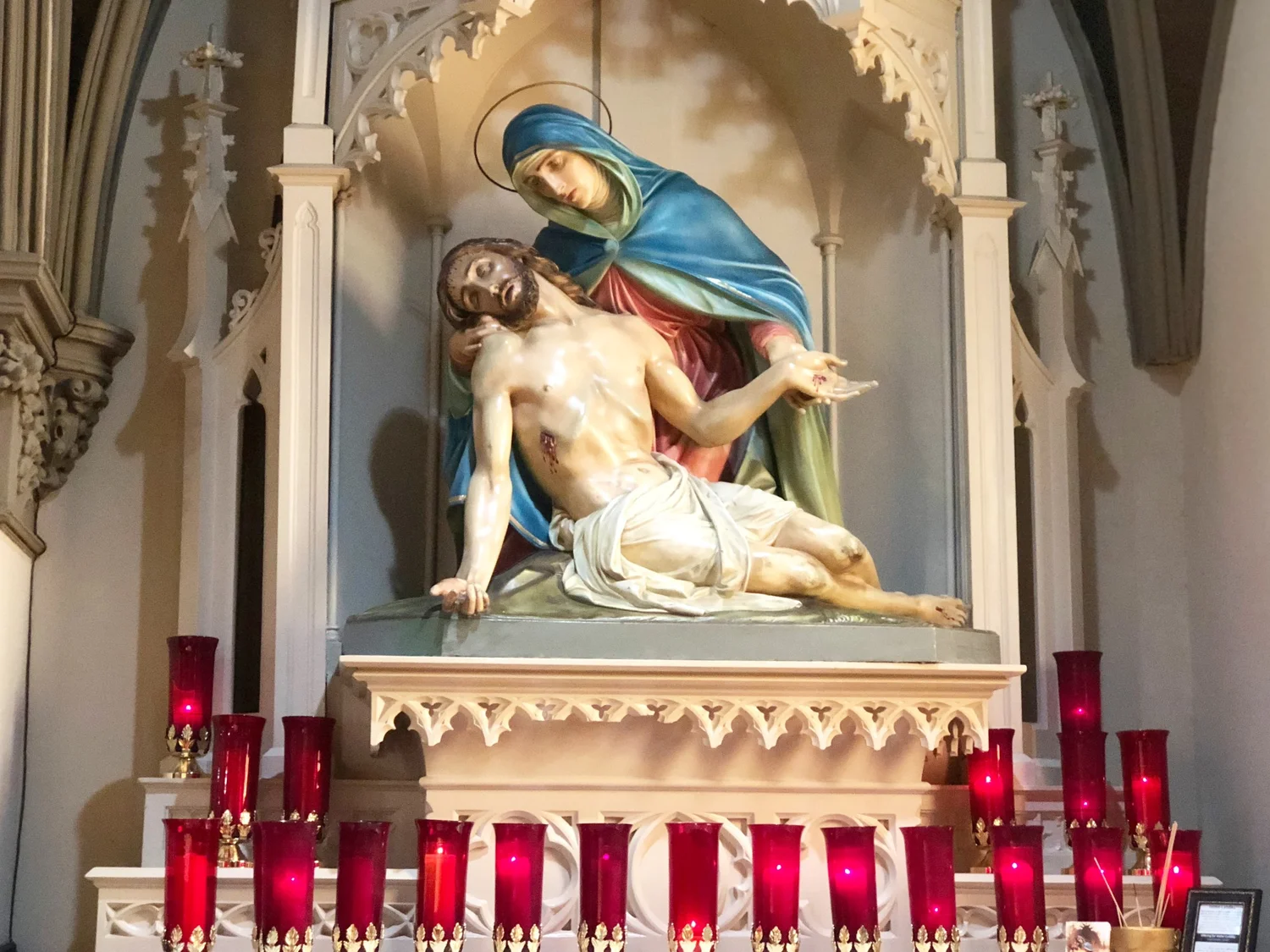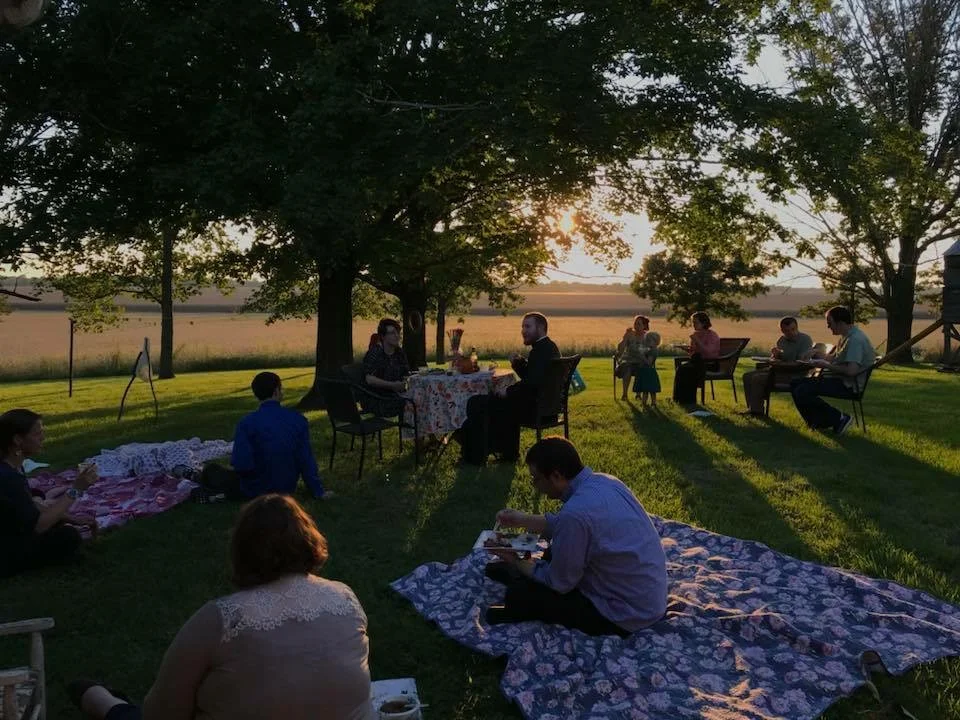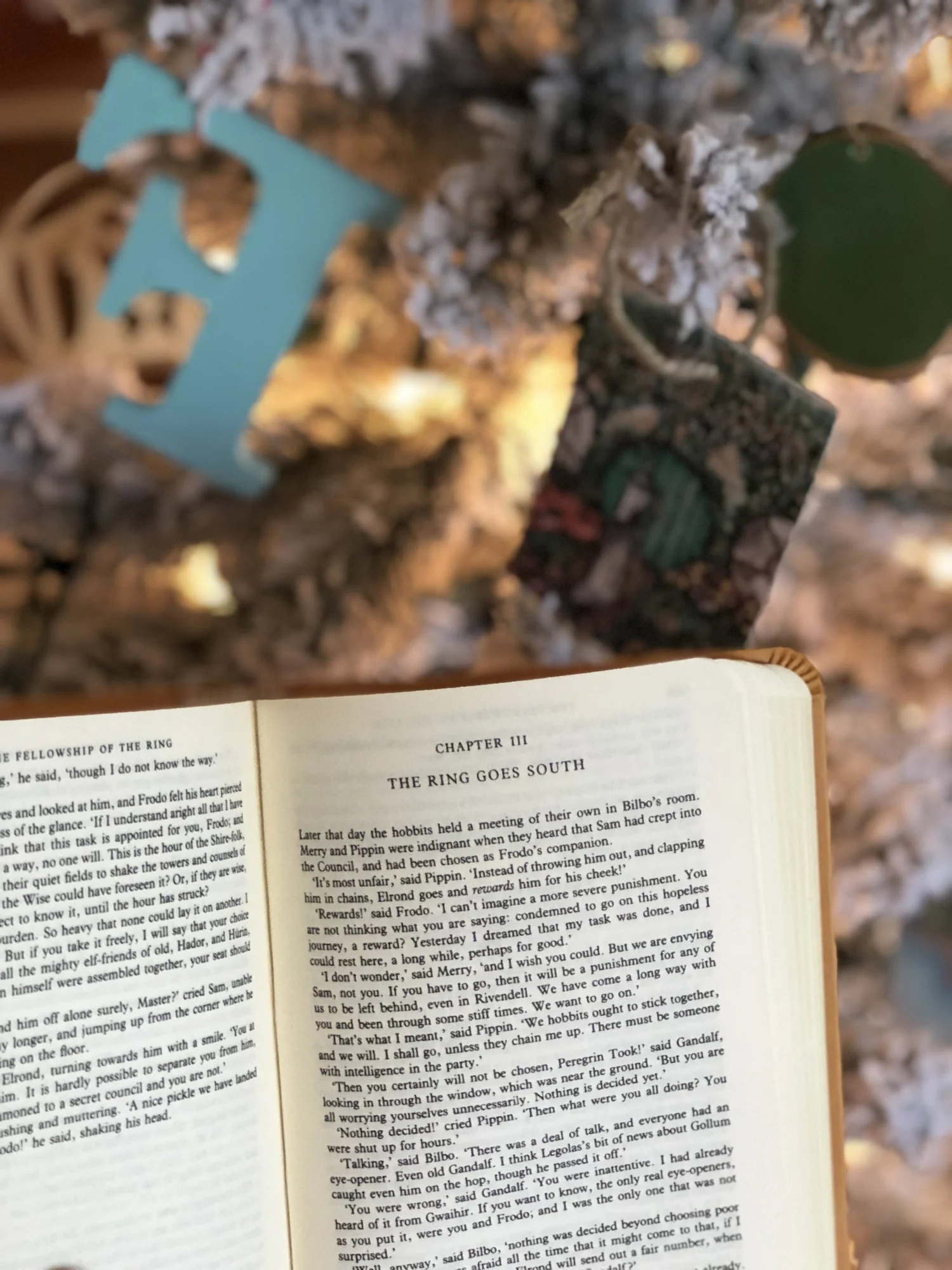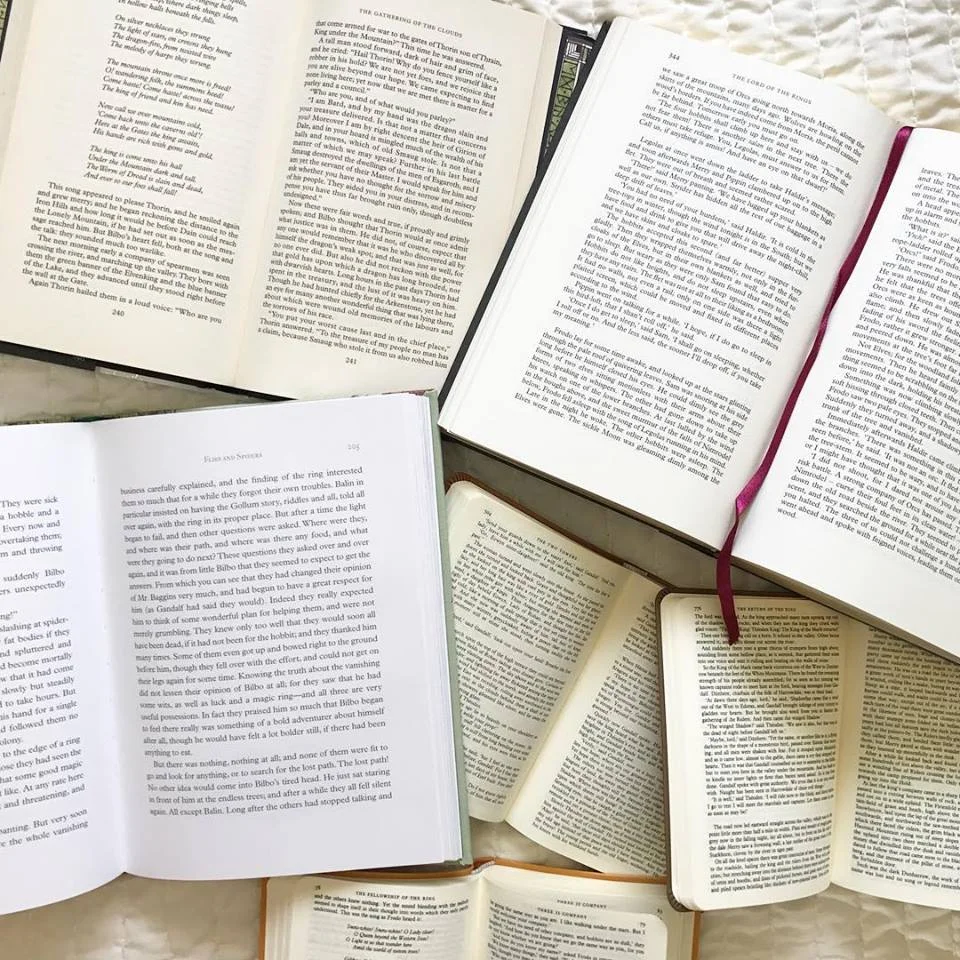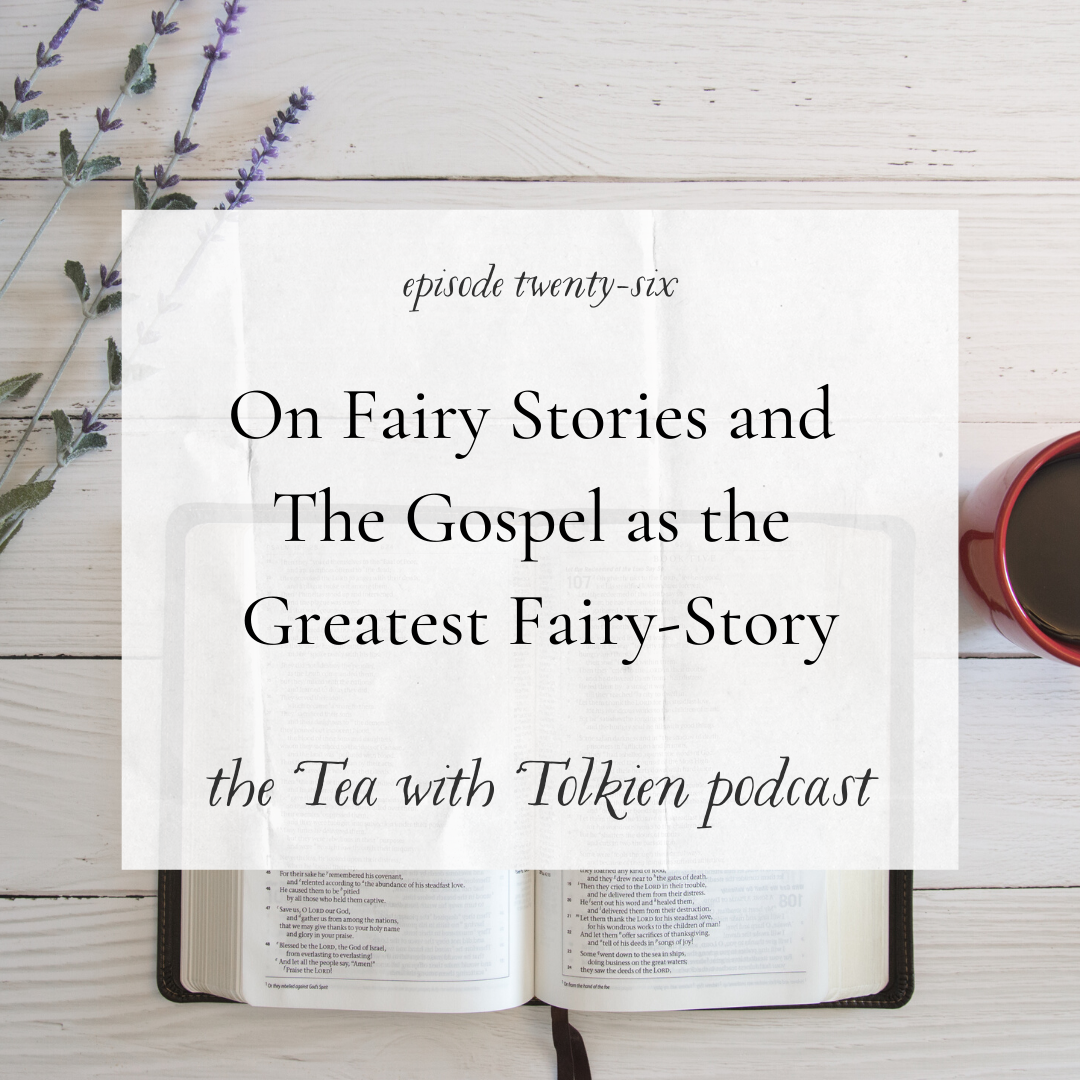Tea with Tolkien
Join us for a cup of tea as we grow together in Hobbitness and Holiness, inspired by the faith and philosophy of JRR Tolkien.
For show notes, visit www.teawithtolkien.com/podcast/silm10
For show notes, visit www.teawithtolkien.com/podcast/silm10
For show notes, visit www.teawithtolkien.com/podcast/silm9
For show notes, visit www.teawithtolkien.com/podcast/silm8
For show notes, visit www.teawithtolkien.com/podcast/silm7
For show notes, visit www.teawithtolkien.com/podcast/silm6
For show notes, visit www.teawithtolkien.com/podcast/silm5
This book club will run through the end of May and then we’ll begin a new book club in the fall. If you have any suggestions for our fall book club, keeping in mind that it should be something written by Tolkien or at least someone Tolkien-adjacent, you can find me on instagram or twitter @teawithtolkien.
If you’d like to sign up, you can do so here.
For show notes, visit www.teawithtolkien.com/podcast/silm4
If you’re following along with our Tea with Tolkien book club, this is week two of our The Silmarillion read-along! We are only on week two out of twenty, and we haven’t covered too much ground already so if you’d like to jump in there’s still time!
This book club will run through the end of May and then we’ll begin a new book club in the fall. If you have any suggestions for our fall book club, keeping in mind that it should be something written by Tolkien or at least someone Tolkien-adjacent, you can find me on instagram or twitter @teawithtolkien.
If you’d like to sign up, you can do so here.
For show notes, visit www.teawithtolkien.com/podcast/silm3
If you’re following along with our Tea with Tolkien book club, this is week two of our The Silmarillion read-along! We are only on week two out of twenty, and we haven’t covered too much ground already so if you’d like to jump in there’s still time!
This book club will run through the end of May and then we’ll begin a new book club in the fall. If you have any suggestions for our fall book club, keeping in mind that it should be something written by Tolkien or at least someone Tolkien-adjacent, you can find me on instagram or twitter @teawithtolkien.
If you’d like to sign up, you can do so here.
So this week we’re discussing the first part of The Silmarillion, "Ainulindalë: The Music of the Ainur" as well as Valaquenta. These two chapters are separate from the Quenta Silmarillion, or the Silmarillion proper as it’s often referred, which we are beginning next week.
For show notes, visit www.teawithtolkien.com/podcast/silm2
If you’re following along with our Tea with Tolkien book club, this week we are beginning with our The Silmarillion read-along! If you’d like to sign up, you can do so here.
Before we dive into the The Silmarillion next week, I thought it would be helpful to spend a bit of time reading and discussing The Waldman Letter.
The Waldman letter is a letter written to Milton Waldman, an editor and advisor to publishers in London, who had expressed and interest in The Lord of the Rings and The Silmarillion after the widespread success of The Hobbit. For context, The Hobbit was published in 1937, this letter was written in 1951, and The Fellowship of the Ring would not be published until 1954.
Tolkien had hoped to published LOTR and The Silmarillion together and this letter reflects his belief that the two were interdependent.
The letter can be read in a few places:
In part, on the Tolkien Estate Website (there is a large chunk missing in the middle in which Tolkien writes about the creation of his world and its history through the Second Age)
The Letters of JRR Tolkien, Letter 131
In the preface to The Silmarillion (second edition only)
This letter is important because it pieces together all of Tolkien’s stories concerning Middle-Earth, showing how they are all a part of the same great tale.
What’s in the Waldman Letter?
“My dear Milton, You asked for a brief sketch of my stuff that is connected with my imaginary world…”
Tolkien writes that he can’t remember when he wasn’t building his imaginary world or its languages, noting that almost all the names in his world are derived from these languages. This gives his works a specific kind of consistency which others may not have.
Tolkien has always been passionate about myth, desiring a myth that could be uniquely English.
Tolkien addresses that three major themes of his works are Fall, Mortality, and Machine.
He then goes on to write about the Magic of the Elves as Art versus the enemy’s use of Machine
After that, he launches into a summary of his world’s history, from its creation all the way through its third age, which I will not attempt to summarize myself for the sake of brevity and in hopes of simply encouraging you to read this letter for yourself.
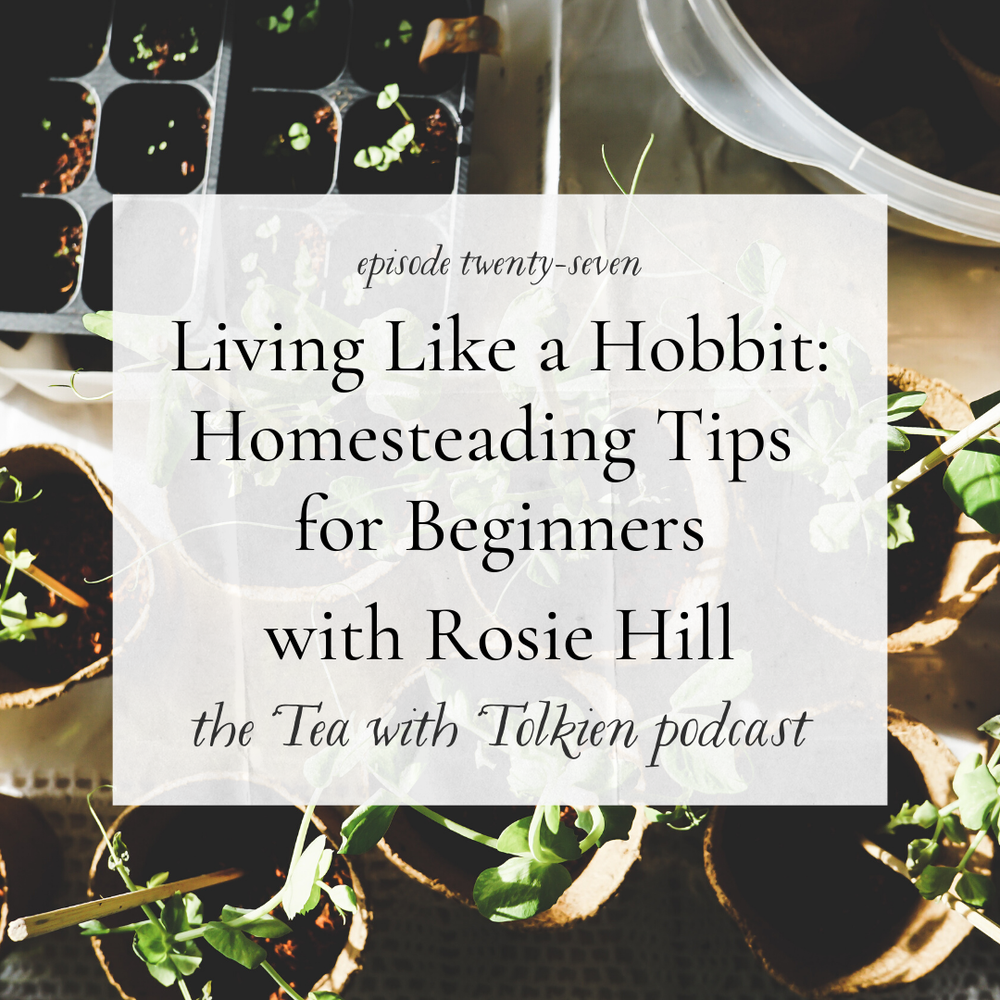
This week we’re joined by Rosie Hill of A Blog for My Mom to chat about her family’s homesteading journey! Rosie shares about her experience, what she’s learned, and her favorite resources for anyone interested in taking steps towards living like a hobbit in this way. I hope you’ll enjoy it!
Me in February: trying to convince everyone to start a garden, bake their own bread, and homeschool
— Rosie Hill (@RosieHill425) March 26, 2020
Everyone: *not caring*
Me in March: trying to convince everyone to start a garden, bake their own bread, and homeschool
Everyone: *asking me all the questions bc IT'S HAPPENING*
Connect with Rosie
Mentioned in this Episode
So if you’re listening to this right now in the Long Lent of 2020, we are currently in the midst of a pandemic due to the coronavirus! I hope if you’re listening at some point in the future that things have settled down and everything is just fine and we’ve put this whole thing far, far behind us…
But right now, we’re all struggling. I don’t know anyone who hasn’t been affected by this.
On top of worrying about the actual virus, many of us are also experiencing a sudden loss of income, a dramatic change in our daily routine, some of you I know have been alone in your apartment for weeks and are having a difficult time adjusting to simply being alone all the time. You need a hug. I hope this can be like a virtual hug in whatever way that’s possible.
Healthcare workers like my husband and many of our friends are working extra hours under higher stress, and many others are navigating working from home… It’s just all around very stressful for everyone in a lot of different ways.
I wanted to share this episode with our current situation in mind but I think it will be useful for any time you find yourself having to stay at home for long periods of time, or honestly whenever you need a little encouragement or inspiration to be a bit more Hobbity.
I also wanted to say that staying home, social distancing, self-quarantine… whatever you call it… would naturally be very difficult for Hobbits as they loved spending time with each other, throwing parties, gathering at the pub to gossip about Bilbo and Frodo… and it’s okay that it’s hard for us too.
We were created to live in fellowship and we are being asked to make this sacrifice for the time being, and I just wanted to acknowledge that it’s okay if you’re struggling with this. That being said, I hope sharing these ideas will help you feel a little inspired and cheered up and ready to choose well what to do with this time that’s been given to you.
Read | This one might seem obvious, but log out of Netflix and pick up a book! Scrolling through twitter for 14 hours a day is not good for you, ask me how I know. Obviously I’m going to recommend reading Tolkien. If you haven’t read The Lord of the Rings yet, now’s your chance. And if you have but you haven’t read The Silmarillion, do it! If you’ll be ordering books online, check if any of your local bookstores offer online shopping, or try getting it straight from the publisher if possible. Smaller businesses are hurting right now, so try to support them if you can.
If you need any other book recommendations, visit teawithtolkien.com/bookshelf for all of my book reviews and my to-be-read list. Many of them are available on the Kindle, so you don’t have to worry about going to a bookstore or ordering anything online.
Go Outside | I can’t help but imagine a bunch of hobbits sitting on their front porches yelling to one another about potatoes and cabbages. If you have a porch, so sit on it! In whatever way you’re able, even if it’s just opening a window and breathing a little fresh air -- DO IT. I try to take a walk everyday with the kids and it helps so much. So if you’re able to take a walk, take a walk. If you can’t go outside at all, open your windows and let the sunshine in.
Pray | Tolkien recommended ‘making a habit of the praises’ in a letter to his son, especially in times of distress. He also wrote, “It is also a good and admirable thing to know by heart the Canon of the Mass, for you can say this in your heart if ever hard circumstances keep you from hearing Mass..." which feels very applicable as all public Masses in the US are currently suspended. The prayers Tolkien recommended can be found at www.teawithtolkien.com/blog/prayers.
Be Creative | Spend some time sitting with your own thoughts and then create something! Pick up a notebook and journal, write poetry, paint, or draw. I’ve noticed a lot of artists I follow on Instagram have been teaching mini courses in their instagram stories, and there is an abundance of free information on YouTube as well. Doing something creative can help relieve the stress you’re feeling so I really do recommend giving it a try even if you don’t feel like a “creative” person.
Write a Letter | Tolkien writes in the prologue to The Lord of the Rings, “By no means all Hobbits were lettered, but those who were wrote constantly to all their friends (and a selection of their relations) who lived further off than an afternoon’s walk.” Following their example, write a few letters to a few of your friends (and maybe just one to a relative).
Cook | With more time at home and many restaurants and delivery services closed, now is the perfect time to learn your way around a kitchen if you don’t already. I know this is tricky because a lot of grocery stores are out of pantry staples like flour and such, but this is another opportunity to be creative. I’ll link to a few Hobbit-inspired food blog posts in the show notes: Food of the Shire, What Hobbits Like to Eat, The Feast Goes on and Ever On, and 7 Shire-Worthy Recipes for National Hobbit Day.)
Bake Lembas |If you’re able to get your hands on a few cups of flour, bake a batch of Lembas! I have my own recipe on my blog -- you can find it by searching “Tea with Tolkien Lembas” But maybe just half a batch for now since it does make quite a bit.
Become a Gardener | Depending on where you live, it may or may not be time to start planting! If it’s still a bit early, now is a good time to do your research and make your plans for your garden. Even if you don’t have a yard, you can start a little herb garden on your windowsill.
Donate Items | While I won’t be dropping off my donations for at least a few weeks, I’ve started going through different areas of the house and bagging up items we don’t use or need anymore. I’m keeping all the bags in the basement until we can go drop them off later. Also, if you do have an excess of any items that people might be needing right now (like, I don’t know, TOILET PAPER?), donate those right away!
Sit Beside the Fire and Think | Whether you light a big fire in your fireplace or simply light a few candles, take some time out of whatever else it is you’re doing (scrolling twitter and stressing out?) and read, think, pray, or write in the relaxing, warm glow of the firelight.
Do something inconvenient for the sake of another | This really is at the heart of what it means to be a Hobbit. Throughout all of their tales, Hobbits go out of their way to support and care for one another. If you have an elderly neighbor or know someone who is struggling right now, ask them how you can help. And while you’re at it, call your grandparents!
Obviously I’m not going to solve all of the world's problems with a podcast episode but I hope this brightened up your day and kinda helped get you thinking about ways to spend your time while stuck at home.
If you liked these ideas, I wanted to recommend my eBook, Thirty Days in the Shire! It’s only $6 and serves as a guide for becoming more of a Hobbit at Heart over the next thirty days. You can learn more and order your copy at teawithtolkien.com/30days if you’re ready to slow down, simplify, and grow!
Anyways, I’m so happy to be back talking to you all! I hope to have more episodes out for you soon, and if there’s anything you’d like to hear about please feel free to let me know on twitter or instagram @teawithtolkien. Have a lovely day!

Hi guys! I’m sure you’ve noticed we’ve taken a break from the podcast this past month but I wanted to pop back in with this short episode in which I was joined by Haleigh DeRocher of Sweet Sequels. Black Friday is literally upon us even though it’s only Thursday evening as I’m recording this, and Haleigh’s etsy shop is one of my favorite places to find unique bookish gifts and she’s running a lovely sale so be sure to check her shop out!
And before we jump into the episode I wanted to remind you that the Tea with Tolkien pop up shop is only open for only TWO more days — we’ll close at the end of the day on November 30th! We’ve got our Hobbit at Heart hoodies and mugs and Christmasy totes and onesies and more, so check it out — I’ll leave the link in the show notes or you can just go to etsy.com/shop/teawithtolkien.
We’re also running a Small Business Saturday / Black Friday sale so you can save $20 off orders of $100 or more with code FRIDAY20 or get 10% off your entire order with code SAVE10.
So a little bit more about Haleigh. She’s a super talented artist who focuses on creating pieces inspired by her favorite books, so of course there are tons of references to Tolkien and C.S. Lewis as well as plenty of other authors in her shop. I’ve been following her on instagram for years now and I was so excited when she agreed to create the beautiful cover art for my Lord of the Rings companion journal and devotional, To Middle-Earth and Back Again. It turned out so well and since we had this connection, I wanted to talk to her for just a little bit about her art and such. I hope you’ll grab a cup of tea and enjoy this conversation!
Recommended Reading

This week, we are joined by Daniel Stewart to chat about living like a Hobbit, beekeeping, and our favorite bear-man Beorn! I learned a ton about beekeeping and I hope you will too!
About this week’s guest:
Daniel is a husband, father, beekeeper, whisky maker, and Tolkien fan. He lives in Waco, TX with his wife and four children.
Links:
In this episode, we are joined for Tea by Father Dan Bedel! We talked about one of Tolkien’s lesser-known works, Leaf by Niggle, as well as Tolkien’s Catholic faith, Harry Potter, and the upcoming Lord of the Rings tv show being produced by Amazon.
Tolkien writes that this story is “the only thing I have ever done which cost me absolutely no pains at all. Usually I compose only with great difficulty and endless rewriting. I woke up one morning (more than 2 years ago) with that odd thing virtually complete in my head. It took only a few hours to get down, and then copy out. I am not aware of ever ‘thinking’ of the story or composing it in the ordinary sense.” - Letter 98
“I recollect nothing about the writing, except that I woke one morning with it in my head, scribbled it down -- and the printed form in the main hardly differs from the first hasty version at all. I find it still quite moving, when I reread it. It is not really or properly an ‘allegory’ so much as ‘mythical’. For Niggle is meant to be a real mixed-quality person and not an ‘allegory’ of any single vice or virtue…” - Letter 241
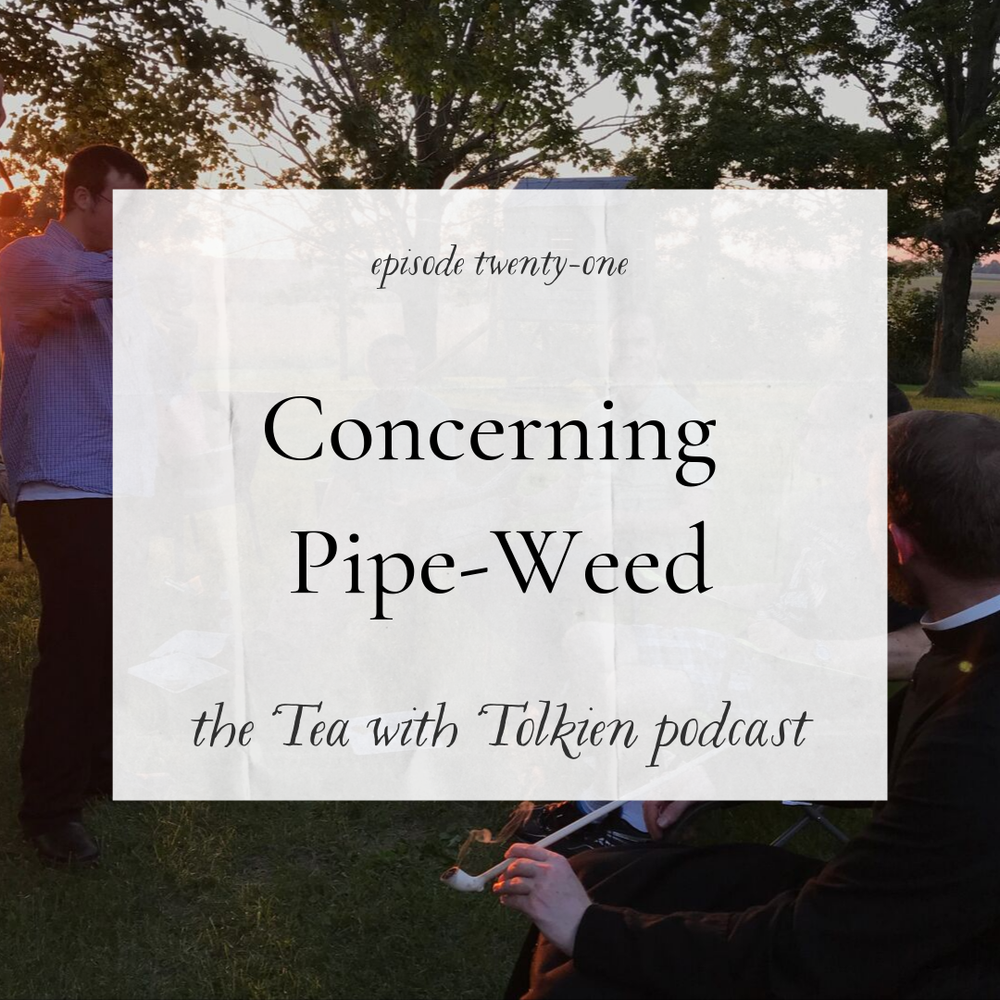
Today we’re talking about something near and dear to every hobbit’s heart, the history and art of smoking pipe-weed.
Obviously I want to be clear that this is something to be enjoyed in moderation by adults, and I know for many smoking can become an addiction so I just want to note that we aren’t endorsing illicit use of pipe tobacco and if you are prone to addiction or are struggling with addiction, this might not be a good episode for you. But because it’s such an important aspect of Hobbit history and culture, I did think it would be fun to have a chat about it.
Concerning Pipe-Weed, from the Prologue to The Lord of the Rings
“There is another astonishing thing about Hobbits of old that must be mentioned, an astonishing habit: they imbibed or inhaled, through pipes of clay or wood, the smoke of the burning leaves of a herb, which they called pipe-weed or leaf, a variety probably of Nicotiana. A great deal of mystery surrounds the origin of this peculiar custom, or ‘art’ as the Hobbits preferred to call it. All that could be discovered about it in antiquity was put together by Meriadoc Brandybuck (later Master of Buckland), and since he and the tobacco of the Southfarthing play a part in the history that follows, his remarks in the introduction of this Herblore of the Shire may be quoted…” - Concerning Pipe-weed
The smoking of pipe-weed, writes Merry Brandybuck, “is the one art that we can certainly claim to be our own invention.”
Today we’re chatting with one of our patreon supporters, Timothy Martin! If you’d like to support Tea with Tolkien, you can learn more about our mission and the rewards here.
Highlights from this Week’s Conversation:
Pipe-weed obviously means a lot to Hobbit culture as a whole, so I wonder if Tolkien loved it as much as they did? Do you know what kind of tobacco he preferred?
Tolkien refers to the smoking of pipe-weed as an “art” in the prologue to The Lord of the Rings. I feel like this ties in so well with the idea of Enchantment, the magic of the elves, which Tolkien also describes as an art. In what ways do you see it as an art-form?
You mentioned when we were talking before that you have built sort of an online community for Catholics who also enjoy smoking a pipe. What’s that been like and what fruit have you seen from that community? What was the inspiration for starting this community?
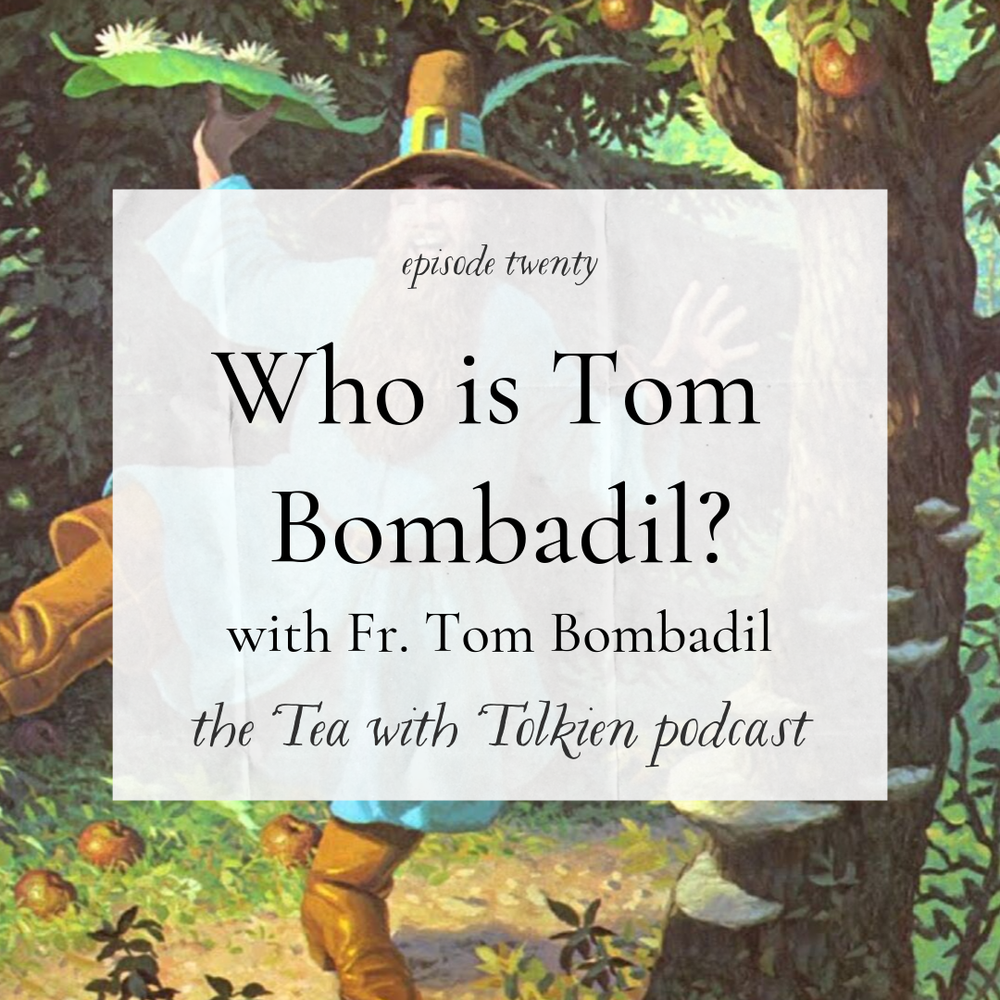
“Old Tom Bombadil is a merry fellow, Bright blue his jacket is, and his boots are yellow. None has ever caught him yet, for Tom, he is the Master: His songs are stronger songs, and his feet are faster.” - The Fellowship of the Ring
This week we’re joined by one of my favorite Twitter Priests! Father Chris Perrella is a priest from the diocese of Bridgeport, Connecticut, but he goes by Father Tom Bombadil online and when I was thinking up who I wanted to chat with for this episode, he was the first person I thought of!
In this episode, we discussed different theories to the ultimately unanswerable question: Who is Tom Bombadil?
I really truly love that Tolkien chose to leave Tom Bombadil as such a mystery, but there are a lot of different fan theories about who he truly is.
Tom Bombadil Theories
Tom represents and un-fallen Adam
Tom is one of the Maiar
Tom is the embodiment of Arda, a Father Nature figure
Tom is the embodiment of the Music of the Ainur
In this episode, we discussed these theories and which we felt were most likely. What do you think of these? Do you have any other Tom Bombadil theories?
In the end, we can’t really truly know, but it’s one of those fun elements of studying Tolkien that I enjoy!
To find Father Tom Bombadil (aka Father Chris) on Twitter, click here.

Because our book club is beginning our read-along of The Silmarillion in a little less than two weeks (September 9th), I wanted to have my friend John Carswell on the show to chat about The Silmarillion as well as tips and resources for those of you who might be reading this masterpiece for the first time.
John is the co-host of the first Tolkien podcast I ever got really into, The Tolkien Road, as well as the author of two books on The Silmarillion -- Tolkien’s Requiem and Tolkien’s Overture. Both of these have been incredibly helpful for me personally in the past few years as I read The Silmarillion for the first and second time. I’ll add links to both in the show notes so you can order copies for yourself.
I also wanted to let you all know that if you do want to join in on the book club, there’s still time to grab your copy of The Silmarillion and get ready. We will begin discussing Ainulindalë on September 9th in our free Discord server -- if you’re unfamiliar with Discord, it’s basically a group chat so you can jump into the discussion whenever you’re able throughout the week. If you’d like to download our Silmarillion reading schedule and get the link to our Discord server, you can sign up using your email address at www.teawithtolkien.com/silmarillion. And if you’re listening to this episode way in the future, you can go to www.teawithtolkien.com/book-club to see what we’re reading next.
Mentioned in this Week’s Discussion
Recommended Reading
Find the show notes at www.teawithtolkien.com/podcast/16
All of the show notes for this episode are available at www.teawithtolkien.com/podcast/15
Pull up a cozy chair and join us as we chat about the works and Catholic faith of J.R.R. Tolkien! I hope this podcast encourages you to carry a little piece of Middle-Earth into your own life as we grow together in hobbitness and holiness. Thanks so much for listening!
‘How do I feel?’ he cried. ‘Well, I don’t know how to say it. I feel, I feel’ — he waved his arms in the air — ‘I feel like spring after winter, and sun on the leaves; and like trumpets and harps and all the songs I have ever heard!’
If you listened to our Tolkien Reading Day episode yesterday, this is one of my favorite Tolkien quotes that I had mentioned. And today I wanted to talk a bit more about it and Spring in general, particularly because last week marked the beginning of Spring for us and because March 25th is of course the day on which the Ring was destroyed as well as the Feast of the Annunciation.
Spring represents or calls to mind images of hope, new life, a fresh start, the light after dark, warmth after the cold, cleansing rains, a gentleness after the harshness of winter. It is soft, and joyful, a season to be celebrated. Tolkien was a lover of myth and symbol and the natural rhythms of the seasons, and the way The Lord of the Rings flows is a testament to that.
Tolkien writes in Letter 210, “Seasons are carefully regarded… They are pictoral, and should be, and easily could be, made the main means by which the artists indicate time-passage. The main action begins in autumn and passes through winter to a brilliant spring: this is basic to the purport and tone of the tale.”
Tolkien, being a devoted Catholic, lived in line with the Church’s liturgical calendar. To Catholics, Spring is closely associated with Easter: the Resurrection, which Tolkien called the Greatest Eucatastrophe.
In Letter 89 he wrote, “The Resurrection was the greatest ‘eucatastrophe’ possible in the greatest Fairy Story — and produces that essential emotion: Christian joy which produces tears because it is qualitatively so like sorrow, because it comes from those places where Joy and Sorrow are at one, reconciled, as selfishness and altruism are lost in Love. Of course I do not mean that the Gospels tell what is only a fairy-story; but I do mean very strongly that they do tell a fairy-story: the greatest. Man the storyteller would have to be redeemed in a manner consonant with his nature: by a moving story. But since the author of it is the supreme Artist and the Author of Reality, this one was also made to Be, to be true on the Primary Plane….”
After death, comes life; after winter, comes spring. And we see this all over the place in his writings as they are so rooted in both physical actual time, as he had mentioned before, and in the symbolism of the seasons. Both Bilbo and Frodo leave Bag end right at the beginning of Autumn, and the Ring is destroyed right at the beginning of Spring…
Pull up a cozy chair and join us as we chat about the works and Catholic faith of J.R.R. Tolkien, and strive to carry a little piece of Middle-Earth into our own daily lives.
Tolkien Reading Day is celebrated on the 25th of March every year, in honor of the day on which the One Ring was destroyed. Since 2003, the Tolkien Society has celebrated this day by encouraging fans to read and share their favorite Tolkien passages, so I wanted to share five of mine. Share yours on social media using the #TolkienReadingDay hashtag, and tag me so I can see, too!
I chose all of these from The Lord of the Rings, perhaps because it's most familiar to me of all Tolkien’s works, but also because it has had the biggest influence on my life and has meant the most to me. The more I read the Silmarillion, the more I fall in love with its depth, but I’m still not as familiar with it to be able to choose my favorite specific passages or chapters. So all of these are from The Lord of the Rings, and I didn’t realize this until now, but all of them are from The Return of the King at that.
This first one is from Book Six, Chapter One. After he believed Frodo to be dead, Sam took the Ring and determined to finish Frodo’s quest for him. However, he learned that Frodo was not actually dead, and he had been taken by orcs and carried away. So Sam is following them now in an attempt to rescue him, but already he is being tempted by the Ring.
“In that hour of trial it was the love of his master that helped most to hold him firm; but also deep down in him lived still unconquered his plain hobbit-sense: he knew in the core of his heart that he was not large enough to bear such a burden, even if such visions were not a mere cheat to betray him. The one small garden of a free gardener was all his need and due, not a garden swollen to a realm; his own hands to use, not the hands of others to command.” - The Return of the King, The Tower of Cirith Ungol
Sam is strengthened by his realized, and continues on. After climbing to the top of the stairs in the Tower of Cirith Ungol and being unable to find Frodo, Sam sinks down and bows his head. However, he then begins to sing:
In western lands beneath the Sun
the flowers may rise in Spring,
the trees may bud, the waters run,
the merry finches sing.
Or there maybe 'tis cloudless night
and swaying beeches bear
the Elven-stars as jewels white
amid their branching hair.
Though here at journey's end I lie
in darkness buried deep,
beyond all towers strong and high,
beyond all mountains steep,
above all shadows rides the Sun
and Stars for ever dwell:
I will not say the Day is done,
nor bid the Stars farewell.
Sam’s song draws the attention of an orc, thinking he’s hearing Frodo. The orc uses a ladder to access the final chamber above, and with that Sam is able to follow the orc up and rescue Frodo.
In the next chapter, The Land of Shadow, Frodo and Sam scramble through Mordor, trying desperately to finish their quest. At one point, they find a place to hide and Sam tells Frodo to sleep while he keeps watch.
“Then at last, to keep himself awake, he crawled from the hiding-place and looked out. The land seemed full of creaking and cracking and sly noises, but there was no sound of voice or foot. Far above the Ephel Duath in the West the night-sky was still dim and pale. There, peeping among the cloud-wrack above a dark tor high up in the mountains, Sam saw a white star twinkle for a while. The beauty of it smote his heart, as he looked up out of the forsaken land, and hope returned to him. For like a shaft, clear and cold, the thought pierced him that in the end the Shadow was only a small and passing thing: there was light and high beauty for ever beyond its reach.”
After the Ring is ultimately destroyed, Frodo and Sam awake to find themselves in the Field of Cormallen. Aragorn is king; Gandalf is returned.; the Ring is gone. All is right with the world once again.
“‘Well, Master Samwise, how do you feel?’ he said.
But Sam lay back, and stared with open mouth, and for a moment, between bewilderment and great joy, he could not answer. At last he gasped: ‘Gandalf! I thought you were dead! But then I thought I was dead myself. Is everything sad going to come untrue? What’s happening to the world?"
‘A great Shadow has departed,’ said Gandalf, and then he laughed, and the sound was like music, or like water in a parched land; and as he listened the thought came to Sam that he had not heard laughter, the pure sound of merriment, for days upon days without count. It fell upon his ears like the echo of all the joys he had ever known. But he himself burst into tears. Then, as a sweet rain will pass down a wind of spring and the sun will shine out the clearer, his tears ceased, and his laughter welled up, and laughing he sprang from his bed.
‘How do I feel?’ he cried. ‘Well, I don’t know how to say it. I feel, I feel’ — he waved his arms in the air — ‘I feel like spring after winter, and sun on the leaves; and like trumpets and harps and all the songs I have ever heard!’
Later on, as the hobbits are brought out before the host of men and met with great praise, Tolkien writes:
“And all the host laughed and wept, and in the midst of their merriment and tears the clear voice of the minstrel rose like silver and gold, and all the men were hushed. And he sang to them, now in the elven-tongue, now in the speech of the West, until their hearts, wounded with sweet words, overflowed, and their joy was like swords, and they passed in thought out to regions where pain and delight flow together and tears are the very wine of blessedness.”
So these are five of my favorite passages from The Lord of the Rings, quotes that have pierced my own heart and hopefully they will resonate with you a little bit, or at least inspire you to read a little or a lot of Tolkien. I’d love to hear about your favorites in the comments below, or you can send me a note on twitter or facebook or instagram!
Also, on a quick final note, today is the opening of our spring pop-up shop! I have a limited selection of some of our most popular items from when our Etsy shop was open and I’m very excited to be able to offer some of them again. It was such a challenge to run our busy Etsy shop while also staying at home with my little hobbits, and so I made the difficult decision to close last December. However, this pop-up shop will be open from today until April 5th! We have a beautiful new design made for Tea with Tolkien by Ash of Daffodils and Ink, as well as our Rose Bookstack tee, our enamel Hobbit at Heart campfire mug, and our Little Hobbit baby onesie.
I also wanted to mention, if you’re on instagram, I’m hosting a giveaway in celebration of Tolkien Reading day this week. The giveaway will close on March 30th and 10pm EST, and I hope it’s you that wins! You can visit my instagram feed, @teawithtolkien, for all of the details and how to enter.
I will be back tomorrow to talk about one of my favorite quotes that I had mentioned in this episode, Sam’s “I feel like spring after winter and sun on the leaves”, as well as a little discussion of the significance of Spring in Tolkien’s writings, so make sure you’re subscribed to the podcast so you won’t miss an episode.
I hope you have a beautiful day, and make sure to read more Tolkien! And drink more tea, too!
Pull up a cozy chair and join us as we chat about the works and Catholic faith of J.R.R. Tolkien as well as how we can carry Middle-Earth into our own daily lives.
I’ve wanted to begin discussing some of Tolkien’s letters every so often and so today I thought we’d talk about Letter 213.
If you don’t know what I’m talking about or why these letters have numbers, it’s because they’ve been compiled and published in this really lovely and insightful book called The Letters of JRR Tolkien, edited by Humphrey Carpenter. I’ll link to it in the show description, I highly highly recommend it…
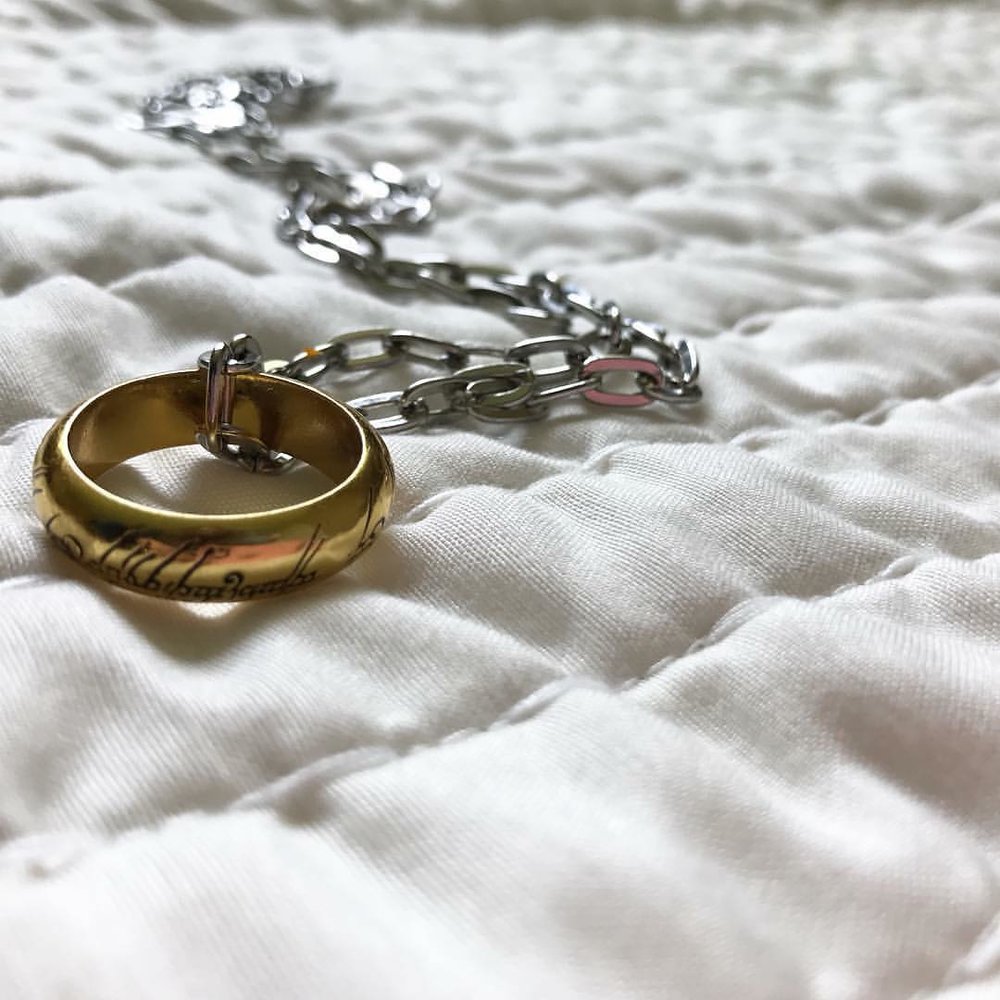
Today I wanted to spend some time with a character I have a very dear place in my heart for and that character is Sméagol, also known as Gollum.
At first glance he’s just this gangly, wicked, nasty little monster that you may find easy to hate. Maybe you even find yourself, like Frodo, wishing Bilbo had simply killed him when he had the chance and that was the end of it.
And yet when we spend just a little bit of time looking for the humanity within Gollum, we find Sméagol, and we are reminded that he himself is a creature worthy of love and yet desperately broken and lost.
I wanted to start out with a little bit of background information on Sméagol before the Ring.
Sméagol spent his early childhood living with his Grandmother. When he was 33 years old, he was fishing with his cousin Déagol who found a gold ring in the water.
I want to pause just for a second here to mention the importance of that age, 33. It isn’t in the books and I haven’t been able to find an actual source for this but I’ve read it in several places and I wouldn’t put it past Tolkien to choose this age intentionally. So you can take it or leave it, but I thought I’d mention it.
His birth year is listed as Third Age 2430 and then the year he got the Ring is approx. 2463 which would put him at 33. He also referred to the Ring as ‘his birthday present’, although it’s unsure if it it was actually his birthday because Sméagol is such an unreliable narrator.
This age is important for a few reasons. First, 33 is the year when a hobbit is considered officially an adult, they’ve come of age. So Sméagol chose to take the Ring as an adult, not as a child.
Second, Frodo was also 33 when he was given the Ring, on his birthday.
So we were talking about this on twitter and @danielhlogan referred to him in this sense as “Frodo’s Shadow”. Sméagol is, in a kind of way, an inverse of Frodo in the way that he came about possessing the Ring and what followed after. Sméagol takes it by force, where Frodo was given the Ring as a gift.
(Also, drawing from Tolkien’s Catholic influence, 33 is the age of Christ when he was crucified. Just wanted to point that out.)
So almost immediately, Sméagol finds himself obsessed with the Ring and ultimately chokes his cousin to death and takes the Ring for himself. After that, he quickly devolved as the Ring corrupted him, he’s kicked out of his grandmother’s home and finds a home for himself in a cave in the Misty Mountains where he lived for more than 400 years.
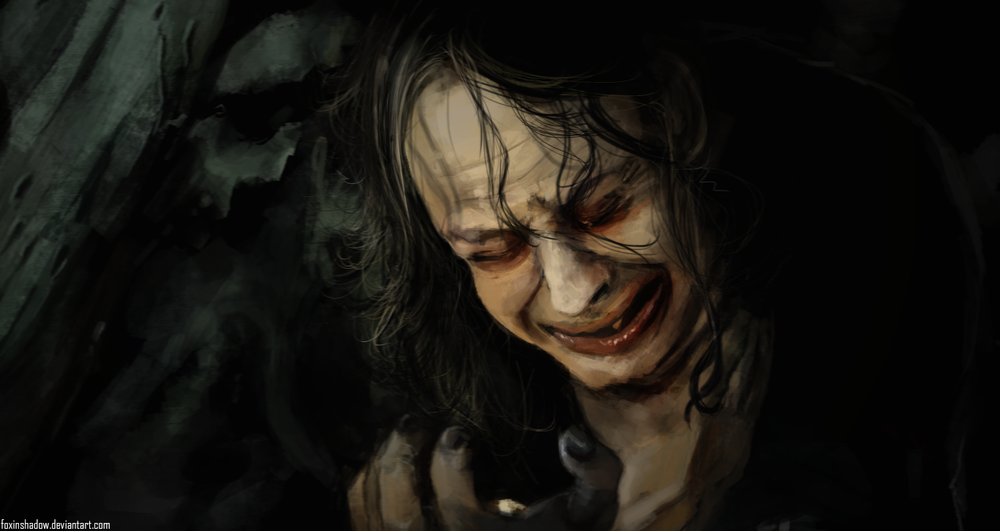
Eventually, Bilbo comes across the Ring and ultimately takes it with him home to the Shire, which leads Gollum to leave the mountains and search in vain for Bilbo. He ends up being captured and tortured in the dungeons of Barad-dur, where he reveals to Sauron what he knew about the Ring. After that, he was freed but then captured by Aragorn and brought to Mirkwood. He then escapes with the help of Orcs and continues searching for the Ring, eventually finding the Fellowship in Moria and following them until he is caught by Frodo and Sam and they take him as their guide.
There’s this quote towards the end of his tale -- Book 4, Chapter 8, The Stairs of Cirith Ungol -- in which we are shown the last flicker of light within his heart and it just kills me, just absolutely kills me.
After hours of sneaking around and plotting, Gollum finds Frodo and Sam asleep. Tolkien writes, “Peace was in both their faces.”
“Gollum looked at them. A strange expression passed over his lean hungry face. The gleam faded from his eyes, and they went dim and grey, old and tired. A spasm of pain seemed to twist him, and he turned away, peering back up towards the pass, shaking his head, as if engaged in some interior debate. Then he came back, and slowly putting out a trembling hand, very cautiously he touched Frodo’s knee -- but almost the touch was a caress. For a fleeting moment, could one of the sleepers have seen him, they would have thought that they beheld an old weary hobbit, shrunken by the years that had carried him far beyond his time, beyond friends and kin, and the fields and streams of youth, an old starved pitiable thing.”
But at this, Sam immediately wakes up and sort of yells at Gollum, accusing him of sneaking and calling him an old villain. In Letter 96, Tolkien calls this “the tragedy of Gollum who at that moment came within a hair of repentance - but for one rough word from Sam.”
“Gollum withdrew himself, and a green glint flickered under his heavy lids.”
Tolkien uses the back and forth of the green gleam or glint in Gollum’s eyes from the grey in his eyes to show us the internal struggle going on within Gollum, this turmoil between Sméagol the Hobbit and Gollum the lonely creature he has become, and after this exchange Tolkien writes “the green glint did not leave his eyes.”
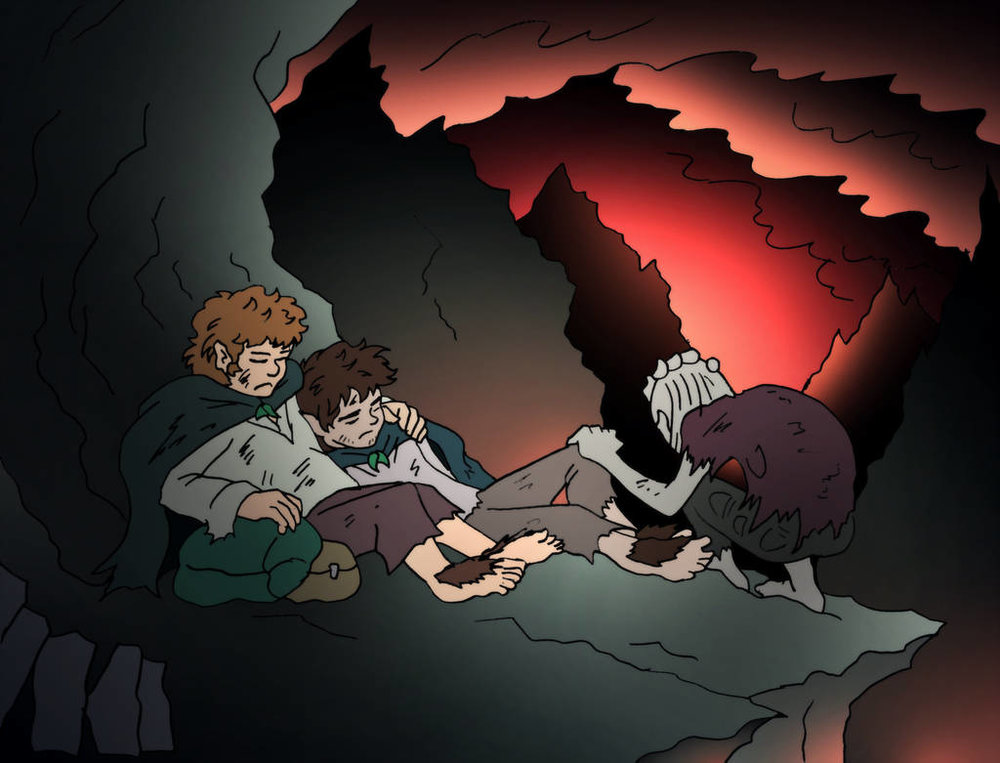
After this moment, I would argue, Sméagol’s fate is sealed. We can’t really know what might have happened if Sam might have reacted differently, and even if Gollum would have had a complete change of heart in this moment there’s nothing to guarantee he wouldn’t have given into the overwhelming desire for the Ring once again. But it still makes me wonder.
Can we blame Sam? I don’t think so. Sam is right not to trust him, after all. And given what he’s gone through and the desperate situation he’s found himself in, I don’t think many of us could say that we would have been any kinder.
But despite his cruel words and his general disdain for Gollum, Sam ultimately chooses the same path as Bilbo when given the chance to kill him.
In Book 6, Chapter 3, Frodo and Sam are scrambling up the Slopes of Doom when Gollum finally finds them once again.
Tolkien writes:
“'Don't kill us,' he wept. 'Don't hurt us with nassty cruel steel! Let us live, yes, live just a little longer. Lost lost! We're lost. And when Precious goes we'll die, yes, die into the dust.' He clawed up the ashes of the path with his long fleshless fingers. 'Dusst!' he hissed.
Sam's hand wavered. His mind was hot with wrath and the memory of evil. It would be just to slay this treacherous, murderous creature, just and many times deserved; and also it seemed the only safe thing to do. But deep in his heart there was something that restrained him: he could not strike this thing lying in the dust, forlorn, ruinous, utterly wretched. He himself, though only for a little while, had borne the Ring, and now dimly he guessed the agony of Gollum's shrivelled mind and body, enslaved to that Ring, unable to find peace or relief ever in life again. But Sam had no words to express what he felt.”
Sam allows Gollum to live, just a little bit longer… and ultimately it is Gollum who brings about the destruction of the Ring.
I find it so fitting and so beautiful that Gollum, most harmed by the Ring, is ultimately the source of its destruction and the world’s salvation from it. It’s a reminder that Providence can work through the most wretched of us to bring about something so beautiful and redemptive.
We are reminded, in the glimpse of his humanity, that even Sméagol was created for goodness— and even though the power of the Ring has caused him to wander so far from his original path, Providence can still work through him to help heal the world.
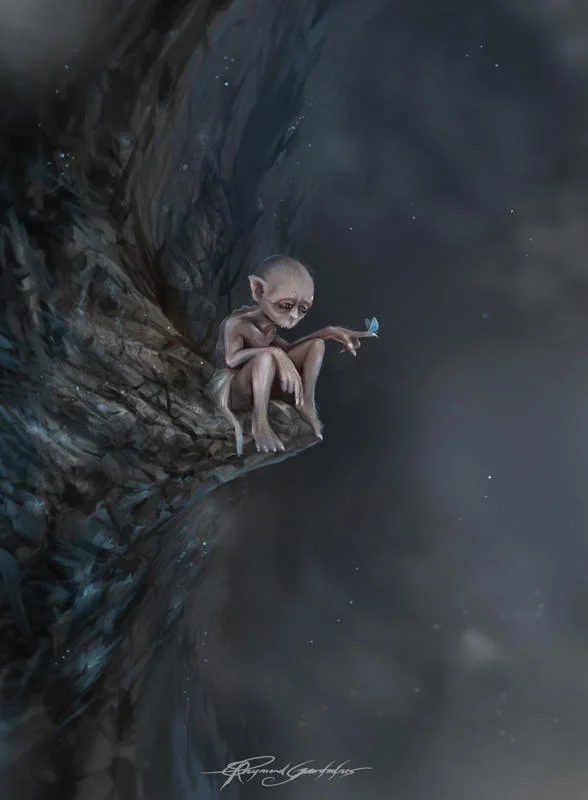
Artist Credit: Shockbolt via DeviantArt
Gollum carried the Ring for nearly 500 years. And as he carried it, it carried him away from everything beautiful or kind or true he had ever known. When Sméagol took the Ring for himself he entered into his own personal hell on earth, we might say, and he was consumed by it until the last moment of his life.
I’ve been thinking about this for a while: can we hold Gollum accountable for his actions? After all, the power of the Ring is far stronger than the will of any simple Hobbit. Even Frodo himself succumbed to it at the last moment.
Tolkien actually addresses it in Letter 181, and it isn’t the happy answer we might have wished for, but I think it’s better than that, it’s a good answer.
He writes, “Gollum was pitiable, but he ended in persistent wickedness, and the fact that this worked good was no credit to him… I am afraid, whatever our beliefs, we have to face the fact that there are persons who yield to temptation, reject their changes of nobility or salvation, and appear to be ‘damnable’... But we who are all ‘in the same boat’ must not usurp the Judge. The domination of the Ring was much too strong for the mean soul of Smeagol. But he would have never had to endure it if he had not become a mean sort of thief before it crossed his path. Need it ever have crossed his path? Need anything dangerous ever cross any of our paths?”
I think, ultimately, we are faced by the truth that although Gollum did not intend to be carried so far away from the light of the world, it was his choice to take the Ring for himself and so the burden of what he became afterward is on him. And I think that should be somewhat alarming for us to recognize in our own selves too!
So what do you think about all of this?
I want to end with another quote from The Stairs of Cirith Ungol, as a reminder that we’re all a part of the same story, the same world. I think often we might be tempted to look at others, maybe those living radically different lives than us, those who believe differently than us, who we disagree with, and we see them as something less than human. And guys, that’s terrible, we can’t do that. Just cut that out immediately. Frodo and Sam and Smeagol, they’re all hobbits, all worthy of love and deserving of mercy.
The choices we make have led us all down our own paths, some deep into the tunnels of the Misty Mountains, some to the dungeons of Barad-Dur, some to the Field of Cormallen… but we’re all a part of the same tale.
“’Why, to think of it, we’re in the same tale still! It’s going on.
Don’t the great tales never end?’
‘No, they never end as tales,’ said Frodo.
‘But the people in them come, and go when
their part’s ended. Our part will end later—or sooner.’”
This week, I was joined by my best friend Theresa Williams! We chatted about a piece she wrote for the Tea with Tolkien blog on the life, writings, and faith of Flannery O’Connor, friendship, and more! I hope you’ll enjoy!
Read Theresa’s piece on Flannery O’Connor here.
You can learn more about Theresa here.
(Also just a quick note, I’m sorry for the kinda wonky audio! I’m still learning how to be a good podcaster so I hope it wasn’t too bad & I’m sure it will be better next time! Ha!)
Thank you all so much for listening to our little podcast! I think you’re all the best and I love being able to have tea with you every week. If you’re enjoying these episodes, I’d love to hear from you! You can send me a note on twitter @teawithtolkien or simply capture a moth and whisper a message to me and I’m sure it will deliver that right along, agh okay not really.
Today we’re going to having a bit of a topical discussion on the subject of Lembas! As well as looking at the Catholic influences behind this, the lovely waybread of the Elves.
We’re first introduced to Lembas in The Fellowship of the Ring when the Fellowship is leaving Lothlorien. As they prepare to set off, Galadriel presents them with several gifts-- both for each individual and the company as a whole. One of these gifts is a bunch of Lembas.
A tiny bit of backstory here because I just learned this as I was preparing for this episode and I t5hought it was cool: Lembas was actually first made by Yavanna, one of the Queens of the Valar, the same that made the Ents, and the recipe was eventually passed down to Galadriel. It’s actually made out of a special corn grown that had grown in Aman. It was also an Elven custom, apparently, that only women should bake it so sorry boys! I should also note that it is extremely rare that Lembas is given to any non-Elves so this occasion of the Fellowship receiving large quantities of it is quite important.
Gimli mistakes it for ‘cram’ but is pleasantly surprised that it’s actually very lovely!
The elves explain basically what it is, how to care for it, and so on…
“Eat a little at a time, and only at need. For these things are given to serve you when all else fails. The cakes will keep sweet for many many days, if they are unbroken and left in their leaf-wrappings, as we have brought them. One will keep a traveler on his feet for a day of long labour, even if he be one of the tall Men of Minas Tirith.”
After this chapter, we see Lembas carries throughout the rest of the story, even as the fellowship has broken, all the way to Mordor -- just makes me wanna cry thinking about it.
One of my favorite things that you can sort of pull out of The Lord of the Rings and bring to life in our own world is Lembas. Tolkien goes to a lot of detail to describe it, so it’s really the sort of thing that we can actually bake ourselves and feel like we’re eating alongside the Fellowship. Even if we might have realized just two seconds ago that Lembas is actually a corn-based cake and I’ve been using wheat flour and almonds this whole time! But that’s okay!
Two years ago, I came up with a recipe based on my own interpretation of Lembas and I’m quite fond of it and I’ll add a link to it in the show notes if anyone else is interested.
It’s basically like a cookie but it’s not very sweet, maybe we would call it a biscuit, and in it we’ve got honey, almonds, orange, and lavender among other things. And of course, it’s very good with tea!
So how does the Eucharist fit into this?
One of the first hints of Catholicism in The Lord of the Rings that I picked up on after my conversion was Lembas.
Of all the Catholic parallels in Tolkien’s writings, Lembas bread is perhaps the strongest as it bears a striking resemblance to the Eucharist (also known as communion).
Tolkien acknowledges this similarity in Letter 213 when he writes about different instances of readers pointing out his Catholic influence, “Another saw in waybread (lembas)=viaticum and the reference to its feeding the will and being more potent when fasting, a derivation from the Eucharist…”
While not allegorical, of course, several characteristics of the Elvish way bread are reminiscent of the Eucharist, so it is worth spending a little time reflecting on its role in the story of Middle-Earth.
So when given to a person near to or in danger of death, the Eucharist is called Viaticum (meaning in Latin: ‘provision for a journey’). Similarly, Lembas is called way bread by the Elves, and is given to the members of the Fellowship as they embark on their perilous quest.
In Book III, Chapter II, Aragorn, Legolas, and Gimli are following after the group of Orcs that had captured Merry and Pippin. Tolkien writes, “Often in their hearts they thanked the Lady of Lorien for the gift of lembas, for they could eat of it and find new strength even as they ran.”
A person cannot receive the Eucharist while in a state of mortal sin without placing themselves in grave danger. Similarly, Gollum cannot eat Lembas and is actually harmed by it. Lembas is also considered more ‘potent’ when it is a person’s sole sustenance, which can be seen as a nod to the Catholic fast before receiving Communion.
And like Lembas must be eaten daily, it is recommended to that Catholics receive the Eucharist often.
In Lembas, the hobbits find renewed strength of spirit and body, often being reminded of home or safer times. Tolkien wrote, in Letter 55, of receiving Communion as “a fleeting glimpse of an unfallen world…’
Similarly, Merry remarks to Pippin that Lembas “does put heart into you! A more wholesome sort of feeling, too...” And the Elves themselves say that it is “more strengthening than any food made by Man.”
In The Return of the King, as Frodo and Sam are almost to the end of their journey, Tolkien writes, “The lembas had a virtue without which they would long ago have lain down to die… it fed the will, and it gave strength to endure, and to master sinew and limb beyond the measure of mortal kind.”
Catholics believe the Eucharist is the Body, Blood, Soul and Divinity of Our Lord Jesus Christ — in which He is truly present. While there is no such parallel within Lembas, its power of nourishment for both body and soul speaks to the influence of the Eucharist on Tolkien’s life.
Tolkien wrote of the Eucharist often in his letters, which were compiled and published 1981 - a book, as always, I highly recommend adding to your bookshelf.
He referred to it as ‘the one great thing to love on earth’, recommending it as ‘the only cure for sagging or fainting faith’.
If you’d like to read more of his thoughts on his faith and the Eucharist, I’d recommend letters 43, 55, 89, 213, and especially 250 — available in “The Letters of J.R.R. Tolkien” edited by Humphrey Carpenter.
I wanted to share two quotes from these letters:
In this one, Letter 43, Tolkien is writing to his son Michael,
“Out of the darkness of my life, so much frustrated, I put before you the one great thing to love on earth: the Blessed Sacrament. . . . There you will find romance, glory, honour, fidelity, and the true way of all your loves on earth, and more than that: Death: by the divine paradox, that which ends life, and demands the surrender of all, and yet by the taste—or foretaste—of which alone can what you seek in your earthly relationships (love, faithfulness, joy) be maintained, or take on that complexion of reality, of eternal endurance, which every man’s heart desires.
Later, in Letter 250, also to Michael, he writes:
"The only cure for sagging or fainting faith is Communion. Though always itself, perfect and complete and inviolate, the Blessed Sacrament does not operate completely and once for all in any of us. Like the act of Faith it must be continuous and grow by exercise. Seven times a week is more nourishing than seven times at intervals.”
One of the coolest parts of Catholicism in my opinion is that not only can we receive the Eucharist during Mass, but we can also participate in something called Eucharistic Adoration.
This is when the consecrated host is placed in a neat sort of holder called a monstrance and it’s displayed, often in an adoration chapel or maybe even in the regular church building for special occasions, and anyone can just come and sit in the presence of our Lord.
Someone asked on Twitter the other day if you need to be catholic to visit an adoration chapel and I was so excited to hear this question honestly because you totally don’t have to be catholic at all! I know a lot of people have found a lot of peace within adoration, even if they don’t really believe in the Catholic teaching that the sacrament is truly Christ present. So if you’ve ever want to attend adoration but weren’t sure about it, you should totally find one nearby and go!
Whenever I feel like everything around me is chaos or I’m struggling with feeling low, I try to run to the Blessed Sacrament as often as I can. A few weeks ago I was in kind of a bad place mentally and so I was able to drive down to adoration every night after my husband came home for a week. That kind of peace and quiet and dedicated alone time in prayer helped pull me out of a pretty dark place and so if you are at all able to, I really really highly 10/10 recommend it.
Catholics refer to the Eucharist as the source and summit of the Christian life, and so I’ve been trying to really anchor myself around this and cling to this truth when I’m kinda feeling like Frodo and Sam on the slopes of Mount Doom.
So to bring it all back together, I just wanted to share how once again learning something more about Tolkien had led me on another winding path into the depths of Catholicism!
I love so much how devoted Tolkien was to the Eucharist and it’s such a balm for my soul to see it, even just in a small way, reflected in Lembas.
I’ll talk to you all next week, but until then I’ll be on twitter and instagram (but mostly twitter) @teawithtolkien…
You might have heard me mention that after hosting my own hobbit parties for the past 7 or 8 years, I’m working on putting together all of my ideas and tips into one resource for all of you! It will be available probably within the next month but instead of selling it on my website, I’m going to first make it available for free to all of my patrons so if you’d like to sign up to become a patron of Tea with Tolkien you can head to patreon.com/teawithtolkien.
The guide won’t be available for purchase on its own until probably August or September otherwise.
Thank you so much for hanging out and having tea with me today!
Just another reminder that I’ll include the Lembas recipe in the show notes if you’d like to make a batch of your own. The recipe makes a ton because it was meant for Hobbit Party prep, but I cut it all in half yesterday when I wanted to make a smaller batch and it turned out perfectly so you can feel free to to do that as well.
I hope you all have a lovely week and we’ll be back next Tuesday for an exciting interview that I can’t wait to share with you!
Resources & Links:
Find all of the shownotes at: www.teawithtolkien.com/podcast
Follow us on twitter @teawithtolkien
:)
To Middle-Earth and Back Again by Kaitlyn Facista (me!)
Sweet Sequels (the etsy shop where I got my Baby’s Guide to LOTR cloth book)
http://www.mi.imati.cnr.it/marco/Who_is_Tom_Bombadil.htm
https://www.tolkiensociety.org/author/faq/#tellme
https://terpconnect.umd.edu/~jkeener/tolkien/getserious.html
Thanks for joining us for a cup of Tea with Tolkien. Follow us, if you’d like at @teawithtolkien on twitter, instagram, and facebook!
This week’s point to ponder: Comparing the culture we live in to that of Hobbiton, why do you suppose our relationships are so much more disconnected than theirs?
The world is indeed full of peril, and in it there are many dark places; but still there is much that is fair, and though in all lands love is now mingled with grief, it grows perhaps the greater. — The Fellowship of the Ring
One of the threads woven throughout all of Tolkien’s writing is grief… so many of the tales of Middle-earth are steeped in sorrow. And so today, I hope it’s alright, I wanted to talk about love and grief, sorrow and joy, and the way they are at one in Eucatastrophe.
We see this paradox most plainly in the lives of the elves. They are the most beautiful of the children of Iluvatar, their goodness and strength are unmatched.
But because of their immortality, they have lived through many lifetimes of men. They have seen the best and the worst…
Galadriel says to Frodo in Book II, chapter 7, that she has spent many ages fighting the “long defeat” as she calls it.
“the long defeat”, a phrase Tolkien also uses in Letter 195:
“Actually I am a Christian, and indeed a Roman Catholic, so that I do not expect ‘history’ to be anything but a ‘long defeat’ –though it contains (and in a legend may contain more clearly and movingly) some samples or glimpses of final victory.” - Tolkien, Letter 195
Within the lifetime of the Elves, they have seen the world as it grows dim. In both a figurative and literal sense. Arda at first was lit by the two lamps, which were knocked down by Melkor, and then the two trees of Valinor, which were destroyed by Melkor and Ungoliant, and then at last the sun and the moon were made. So even just in this sense, the light within the world has diminished…
And so too within all the battles throughout all the ages, the Elves have seen as evil has slowly seeped into every corner of the earth. The long defeat.
And yet, the Elves sing. They are often merry and joyful. They throw the most amazing parties! They are filled with so much goodness and peace despite their sorrow.
In Book I, Chapter IV, Sam says “They are quite different from what I expected –so old and young, and so gay and sad, as it were.’
This kind of paradox of joy mingled with sorrow, I think, is at the heart of The Lord of the Rings. Especially within the tale’s endings.
Tolkien cared so deeply for this concept that he coined the term Eucatasteophe: “the sudden happy turn in a story which pierces you with a joy that brings tears…” - Letter 89
Later in the same letter he wrote:
“The resurrection was the greatest ‘eucatastrophe’ possible in the greatest Fairy Story –and produces that essential emotion: Christian joy which produces tears because it is qualitatively so like sorrow, because it comes from those places where Joy and Sorrow are at one, reconciled, as selfishness and altruism are lost in Love. “
Throughout all of The Lord of the Rings we expedience small moments of Eucatastrophe, when all Hope seems lost for Frodo in the Barrow-Downs and Tom Bombadil Busts In to save them, when Merry and Éowyn face the Witch king of Angmar and destroy him, when the battle seems lost but Hope is rekindled… at the Crack of Doom when Frodo betrays his quest and claims the Ring as his own, but Providence provides another way for it to be accomplished.
But there’s one scene in particular that just stays with me.
We see this mingling of joy and grief within a character that feels so much more familiar, someone I see myself in more than the Elves: Samwise Gamgee.
At the end of the War of the Ring, in Return is the King — The Field of Cormallen
When Sam awakens in Ithilien, he and Frodo have survived their quest, he sees Gandalf before them and asks “is everything sad going to come untrue?”
I’ve found so much comfort in that phrase, and often paired it with Revelation 21:5 “And he who was seated on the throne said, “Behold, I am making all things new.”
Later in this chapter, they are all gathered together in celebration —
“ And all the host laughed and wept, and in the midst of their merriment and tears the clear voice of the minstrel rose like silver and gold, and all men were hushed. And he sang to them, now in the elven-tongue, now in the speech of the West, until their hearts, wounded with sweet words, overflowed, and their joy was like swords, and they passed in thought out to regions where pain and delight flow together and tears are the very wine of blessedness.”
The topic of grief has weighed heavily on my heart over the past few weeks.
January is a difficult month for me, as It marks the anniversary of our miscarriage. I found out I was pregnant on January 9, 2015 only to find out on January 14th that I was losing the baby. Within that span of five days, I experienced so much joy as I fell so hard in love with this little baby, mingled with so much grief as I realized I would never get to hold him or her, to really know them at all.
And even in all of the grief and wondering what things would have been life, even four years later, there is also a sense of peace that I cling to in knowing that our little baby is held so safely in the arms of Jesus.
I found this quote in Letter 45 and I wanted to share it with you all:
There is a place called ‘heaven’ where the good here unfinished is completed; and where the stories unwritten, and the hopes unfulfilled, are continued. We may laugh together yet...” - Letter 45, from 1941
In sorrow we must go, but not in despair. Behold! we are not bound for ever to the circles of the world, and beyond them is more than memory. Farewell!” - Return of the King, Appendix B
Is everything sad going to come untrue?
Behold, I am making all things new…
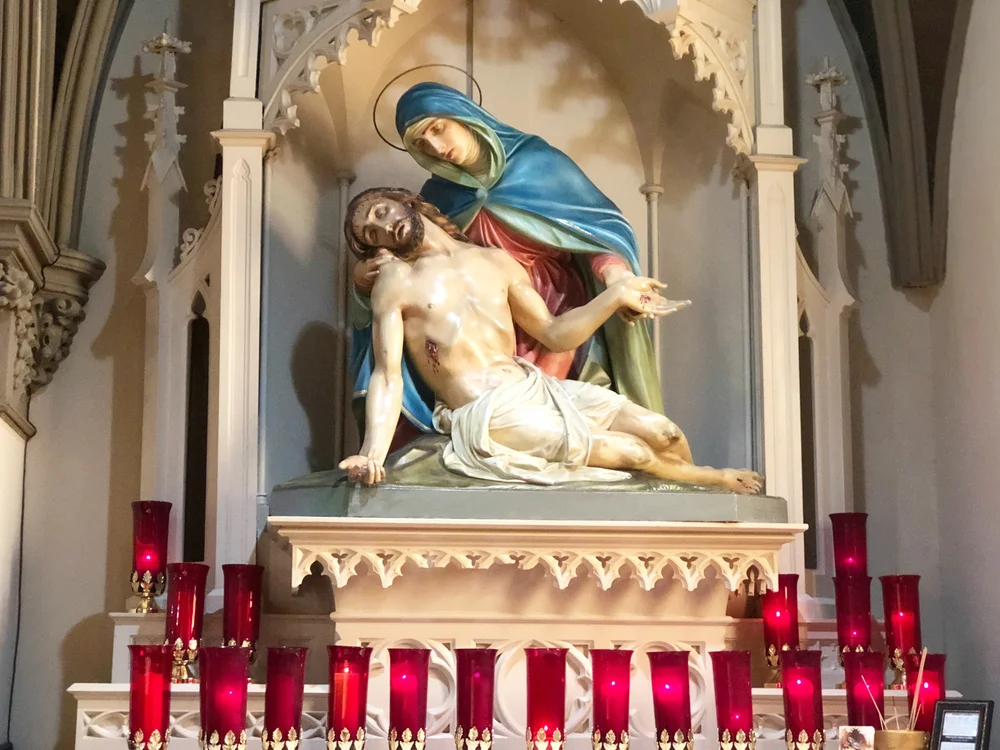
This week I had my husband Alex on to discuss our conversion to the Catholic faith. This is a subject I’ve had a lot of you ask about, so I was excited to be able to chat about it with him. This past weekend was the fifth anniversary of our conversion, so I thought it would be a lovely time. I hope you’ll enjoy it! We also talked about Mabel Tolkien, John Ronald’s mother, and her own conversion and the impact it had on her sons.
In this episode, we talked about:
the different faith traditions we were brought up in
how we first became interested in Catholicism
the somewhat unusual way we were finally received into the Church
talking to our family about our conversion
what it’s been like adjusting to Catholic life
and more!
Links

A few excerpts from Concerning Hobbits
Hobbits “love peace and quiet and good tilled earth: a well-ordered and well-farmed countryside was their favorite haunt.”
“As for the Hobbits of the Shire, with whom these tales are concerned, in the days of their peace and prosperity they were a merry folk. They dressed in bright colours, being notably fond of yellow and green…”
“Their faces were as a rule good-natured rather than beautiful, broad, bright-eyed, red-cheeked, with mouths apt to laughter, and to eating and drinking. And laugh they did, and eat, and drink, often and heartily, being fond of simple jests at all times, and of six meals a day (when they could get them). They were hospitable and delighted in parties, and in presents, which they gave away freely and eagerly accepted.”
“They were, if it came to it, difficult to daunt or to kill; and they were perhaps, so unwearyingly fond of good things not least because they could, when put to it, do without them, and could survive rough handling by grief, foe, or weather in a way that astonished those who did not know them well and looked no further than their bellies and their well-fed faces…”
“The Shire at this time had hardly any ‘government’. Families for the most part managed their own affairs. Growing food and eating it occupied most of their time. In other matters they were, as a rule, generous and not greedy, but contented and moderate, so that estates, farms, workshops, and small trades tended to remain unchanged for generations.”
“There is more in you of good than you know, child of the kindly West. Some courage and some wisdom, blended in measure. If more of us valued food and cheer and song above hoarded gold, it would be a merrier world.” - The Hobbit
Ways to Be More of a Hobbit at Heart
in the New Year
Spend more time outside
Next time it’s nice outside, grab a book and read a little
Go for a hike or walk along a trail
Have a picnic!
Take some breaks from the internet
Consider starting a garden, it can be small if you’re just starting out
Less fast food, more home cooking
Be intentional about being hospitable, make a point of inviting others into your home
Give gifts as often and as generously as you are able
Spend time in fellowship with others
Host at least one party this year
Maybe this year you’ll learn how to brew beer
Maybe smoke a little pipe tobacco with friends
Look for opportunities to humble yourself
Let your Yes mean Yes and No mean No
Frodo didn’t accept the task of carrying the Ring halfheartedly, once he said yes he stayed committed as long as he could
Become a better friend.
Everyone needs a Samwise. Be intentional about becoming a better friend to someone who needs one this year.
Eat more Second Breakfast.
Sit beside the fire and just think every so often, ponder things
Read and write poetry
Host a Hobbit Party! Every September 22 we host a party in celebration of Frodo and Bibo’s birthdays, you should too. I have tons of ideas here.
Favorite Tweets (see the whole thread here)
Zegg Noggenour @zgochenour: (go-ken-hour) The heart of the hobbit lifestyle is hospitality. One of my favorite hobbit practices is giving gifts on your birthday.
hannah ???? @hanmariams -staycations are good
-give yourself an afternoon break for tea
-learn how to garden or at least keep a plant alive from Trader Joe’s
-disappear from birthday parties in dramatic fashion
Robert the Nobody @Robert_in_MN
-Be content with where you are but don't turn down a grand adventure if it's presented to you.
-Wear more bright colours
-Take time to contemplate, preferably with a pipe or tea
-Eat six small meals throughout the day
-Be proud of who you are and where you come from
Get to know and fall in love with your own local area: the woods, the fields, little rivers. Like Sam, become an expert on every nook and cranny of your natural neighborhood. Attachment to place seems very hobbitish.
Start with, "Hobbits are a representation of of how Tolkien saw Chesterton: Authentic, merry, with a pipe and pint."
Links Mentioned
The Giveaway (A Blessed is She Planner!)
View this post on InstagramA post shared by Kaitlyn | Tea with Tolkien (@teawithtolkien) on
Wanna support Tea with Tolkien?
Join our Patreon Community here :)

Merry Christmas! I hope you had a fruitful advent season and that you’re enjoying the beginning of the Christmas season. I hope you’ll be able to find a few minutes to unwind from all of the festivities and have a cup of tea with me and Tolkien today!
I was so excited when I realized Christmas day fell on a Tuesday this year because it meant I would get to record a special Christmas episode. Aside from being Christmas day of course, December 25th is actually quite the important date in The Lord of the Rings as well.
It is the date that the Fellowship left from Rivendell, officially marking the beginning of Frodo’s quest! (but you might not know it without the Appendices -- this date is in Appendix B!)
“Frodo was now safe in the Last Homely House east of the Sea.
That house was perfect, as Bilbo had long ago reported,
‘a perfect house, whether you like food or sleep or story-telling or singing,
or just sitting and thinking best, or a pleasant mixture of them all.’
Merely to be there was a cure for weariness, fear, and sadness.”
Tolkien didn’t choose dates unintentionally, especially considering the date he chose for the destruction of the Ring on March 25th
In The Spirit of Liturgy, then Joseph Cardinal Ratzinger (later Pope Benedict XVI) explained, “Jewish tradition gave the date of March 25 to Abraham’s sacrifice... This day was also regarded as the day of creation, the day when God’s word decreed: ‘Let there be light.’ It was also considered, very early on, as the day of Christ’s death and eventually as the day of his conception.." This date is also the officially celebrated Feast of the Annunciation, the celebration of the Incarnation, Mary's fiat.
Considering its importance in Jewish and Christian tradition, it feels natural that Tolkien chose for March 25th to bear such significance to the history of Middle-Earth. Three major events took place on March 25th: first and foremost, it is the date on which the One Ring is destroyed; secondly, on the same date the following year, Frodo returns home to the Shire; and the following year, Elanor the Fair is born.
So what does it mean that Tolkien chose December 25th as the date the Fellowship left Rivendell?
The journey begins on December 25th, the feast of the Nativity of Our Lord, and ends on the date of his Crucifixion.
This strengthens any ideas we might have had about the Ring representing Sin in some way, or the different ways members of The Fellowship act as Christ figures.
Rivendell is a safe place, a place of refuge and healing, and it is in Rivendell that we see Frodo’s fiat -- he accepts the burden of the Ring no matter what the pains he may experience
So in leaving the safety of Rivendell, we are reminded of Christ’s birth.
Just as Jesus left the safety of Mary’s womb on Dec 25, Frodo is leaving the safety of Rivendell to begin the dangerous and difficult work of the salvation of Middle Earth.
When Jesus is born, he leaves behind the safety and warmth of his mother’s womb and join us in the cold, broken world. Almost immediately he is in danger, as the Holy Family is forced to flee to Egypt to escape King Herod. He has come into the world for a purpose, and he has a hard road ahead of him.
This kind of perspective isn’t really something I had ever reflected on before.
We often see Christmas a joyful occasion, and of course it is, but for Jesus himself it marked the beginning of his life of sacrifice. And I am so grateful to him for accepting this role.
So as we begin to celebrate the Christmas season, in joyous memory of Christ’s birth, we also begin to look forward to lent, Holy Week, to Christ’s crucifixion.
Just as The Fellowship embarks on their quest to destroy the ring, Christ’s birth marks the beginning of his quest towards the destruction of sin and all of the death and brokenness
I hope you all have a beautiful Christmas season!
PS I also wanted to recommend another Christmasy podcast series I think you might enjoy. My friends over at the Roman Circus podcast have put together a series of mini episodes for each of the twelve days of Christmas featuring different guests, and they invited me on for the 5th day of Christmas so I hope you’ll give it a listen.
Our first episode in which I share some of my favorite unexpected books, for those who have already read The Hobbit and The Lord of the Rings! Here are the books mentioned in this episode as well as links to learn more or grab a copy:
Tolkien’s Requiem by John Carswell
Tolkien’s Overture by John Carswell
The Philosophy of Tolkien by Peter Kreeft
Tolkien: Man and Myth by Joseph Pearce
The Messiah comes to Middle-Earth by Philip Ryken
The Flame imperishable: Tolkien, St. Thomas, and the metaphysics of faerie by Jonathan Mcintosh
Tolkien’s Sacramental Vision: Discerning the Holy in Middle Earth by Craig Bernthal
The Gospel According to Tolkien by Ralph C Wood
“John Ronald’s Dragons” by Caroline McAlister
Frodo’s Journey and Bilbo’s Journey (both by Joseph Pearce)
To Middle-Earth and Back Again by Kaitlyn Facista (me!)
What would you add to the list? You can tweet me @teawithtolkien, email me at kaitlyn@teawithtolkien.com, or leave a comment below!
Thanks so much for listening to Tea with Tolkien, a podcast for the Hobbit at Heart! In this episode, I chat a little bit about what my hopes are for this podcast and how I hope to encourage you to read more Tolkien and grow in Hobbitness and Holiness.
Wanna get more connected with the Tea with Tolkien community?
Become a member of our Patreon community!
Follow on twitter!
Read more about the heart of Tea with Tolkien here.
“The world is indeed full of peril, and in it there are many dark places; but still there is much that is fair, and though in all lands love is now mingled with grief, it grows perhaps the greater" - Haldir

Thank you so much for listening to our first little test episode, where I’m joined by my daughters Lily and Marigold. In this episode, we chat about why hobbits have hair on their feet, why Gollum is so scary, and what it’s like to be a hobbit kid. Listen to the very end to hear Marigold saying mama. I hope you like this tiny test episode and I can’t wait to share more (real) podcasts with all of you soon. :)
For show notes, visit www.teawithtolkien.com/podcast/trd2021
Recommended Blog Posts:
How We‘re Celebrating Tolkien Reading Day 2020
Why March 25th Might Be The Most Important Date of all History
Why Middle-Earth Matters: 11 Reasons You Should Be Reading Tolkien
Beyond The Lord of the Rings: Getting to Know Tolkien through his Shorter Works
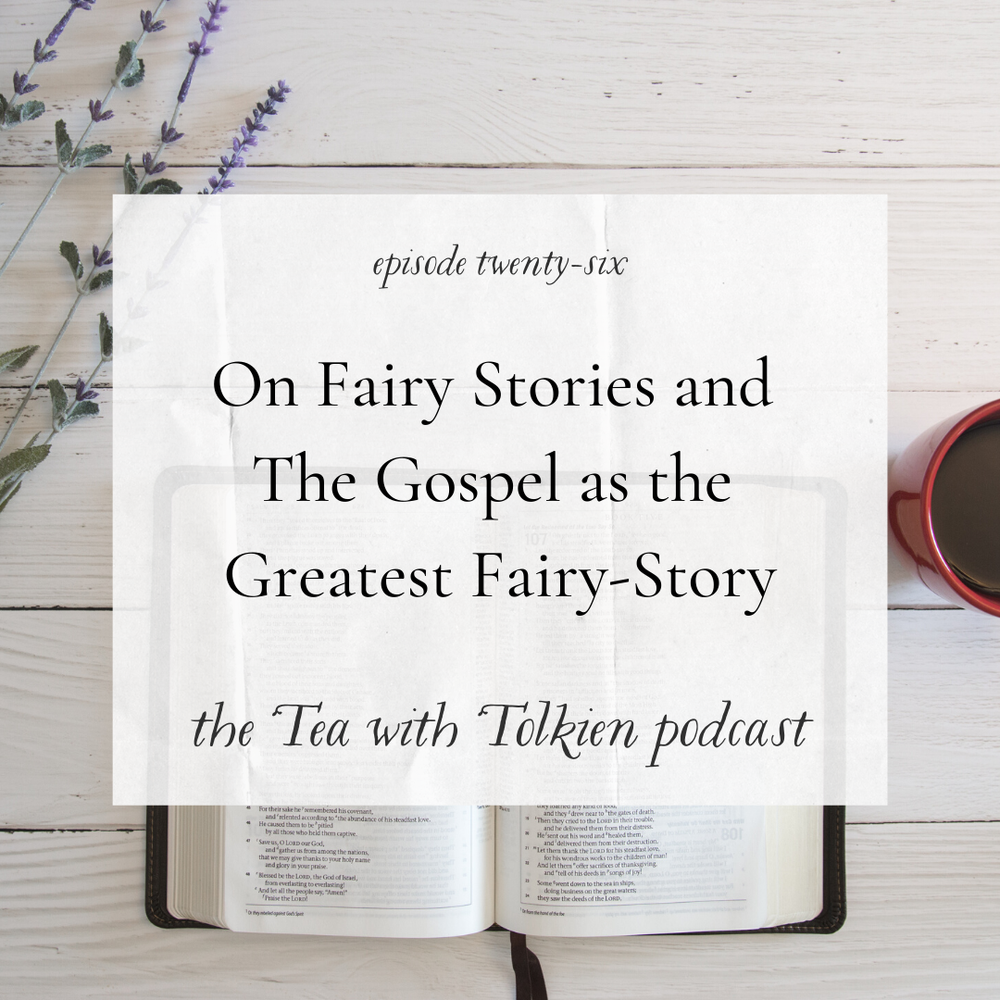
This week, we’re talking about Tolkien’s essay “On Fairy Stories”, looking at Tolkien’s term Eucatastrophe, and how Tolkien calls the Gospels the Greatest Fairy-Story.
I wanted to begin with a little bit on Tolkien’s essay, On Fairy-Stories. Now this is in no way comprehensive because it’s really quite a long essay, but I still wanted to give you all an intro.
Written in 1939, this essay was presented by Tolkien as the as the Andrew Lang lecture at the University of St Andrews, in Scotland. For a bit of context, Andrew Lang was a Scottish poet, novelist, literary critic, and anthropologist with a love for folk and fairy tales. Tolkien’s essay was a response to Lang’s work as a folklorist and collector of fairy tales but it really grew into something much more.
On The Tolkien Estate’s website you can find an essay written by Verlyn Flieger, where she discusses On Fairy -Stories.
“If it were nothing else, “On Fairy-stories” would have a primary place in Tolkien scholarship as Tolkien’s definitive statement about his art — which he called “Sub-creation” — and the concept that lies behind it — the power of words to create a Secondary World. However, “On Fairy-stories” has a good deal more to offer, and to a wider audience, than a simple artistic declaration, however important, to a fellowship of scholars. It is also a wide-ranging discussion aimed at anyone interested in the subject of fairy tales…”
“And finally and above all, it is essential reading for anyone seeking a deeper understanding of the multivalent myth, epic and fairy tale romance that is The Lord of the Rings.”
Verlyn Flieger
Tolkien addresses three questions primarily: What are fairy stories? What are their origins? And what is the use of them? It is also in On Fairy-Stories that we first see the word Eucatastrophe, a term coined by Tolkien himself, which we’ll talk about in a bit.
So if you weren’t sure if it was an essay worth reading, I hope by now you’re convinced!
You can find On Fairy Stories in a few different places. First, there are a few free PDFs floating around the internet and I’m linking to one of them in the show notes. If you’d like to purchase a copy or perhaps find one at your local library, you can find it included in “Tree and Leaf” or “The Monsters and the Critics”. Both are linked at the bottom of this post.
I wanted to read the first few lines of the essay because I think they set the tone quite well for the rest of the essay, as well as my own Tolkien studies.
“I propose to speak about fairy-stories, though I am aware that this is a rash adventure. Faerie is a perilous land, and in it are pitfalls for the unwary and dungeons for the overbold. And overbold I may be accounted, for though I have been a lover of fairy-stories since I learned to read, and have at times thought about them, I have not studied them professionally. I have been hardly more than a wandering explorer (or trespasser) in the land, full of wonder but not of information.”
- JRR Tolkien, On Fairy Stories
If you’ve been listening to our podcast for a while, I think I read this quote in our very first episode because it reflects my own feelings toward reading and studying Tolkien -- I am a lover of Tolkien’s works, although I haven’t studied them professionally (yet).
So after just a super brief introduction to On Fairy Stories, I wanted to discuss a question that’s come up a lot over the years, moreso in my experience in Evangelical circles but it’s also something I’ve heard Catholics wrestle with: Should Christians read fairy tales?
To put it plainly, the answer is yes. In “On Fairy Stories”, Tolkien offers such a beautiful explanation that I wanted to share it with you all. Towards the end of the essay, Tolkien introduces the word ‘Eucatastrophe’, a term of his own invention.
In letter 89 to his son Christopher, Tolkien refers to the essay:
“And all of the sudden I realized what it was: the very thing that I have been trying to write about and explain - in that fairy-story essay that I so much wish you had read that I think I shall send it to you. For it I coined the word ‘eucatastrophe’: the sudden happy turn in a story which pierces you with a joy that brings tears (which I argued in is the highest function of fairy-stories to produces).
And I was there led to the view that it produces its peculiar effect because it is a sudden glimpse of Truth, your whole nature chained in material cause and effect, the chain of death, feels a sudden relief as if a major limb out of join had suddenly snapped back. It perceives -- if the story has literary ‘truth’ on the second plane (for which see the essay) -- that this is indeed how things really do work in the Great World for which our nature is made.
And I concluded by saying that the Resurrection was the greatest ‘eucatastrophe’ possible in the greatest Fairy Story -- and produces that essential emotion: Christian joy which produces tears because it is qualitatively so like sorrow, because it comes from those places where Joy and Sorrow are at one, reconciled, as selfishness and altruism are lost in Love.
Of course I do not mean that the Gospels tell what is only a fairy-story; but I do mean very strongly that they do tell a fairy-story: the greatest. Man the story-teller would have to be redeemed in a manner consonant with his nature: by a moving story. But since the author of it is the supreme Artist and the Author of Reality, this one was also made to Be, to be true on the Primary Plane…”
JRR Tolkien, Letter 89
But not all fairy-tales are created equal, and not all fantastical stories are fairy-tales, at least Tolkien would argue this.
“Far more important is the Consolation of the Happy Ending. Almost I would venture to assert that all complete fairy-stories must have it. At least I would say that Tragedy is the true form of Drama, its highest function; but the opposite is true of Fairy-story. Since we do not appear to possess a word that expresses this opposite--I will call it Eucatastrophe. The eucatastrophic tale is the true form of fairy-tale, and its highest function.”
“It is the mark of a good fairy-story, of the higher or more complete kind, that however wild its events, however fantastic or terrible the adventures, it can give to child or man that hears it, when the “turn” comes,a catch of the breath, a beat and lifting of the heart, near to (or accompanied by) tears, as keen as that given by any form of literary art, and having a peculiar quality.”
- JRR Tolkien, On Fairy Stories
Stories that produce this form of Joy are good for our souls; all small eucatastrophes of the Secondary World will, in the end, point us to, or offer us glimpses of, the Great Eucatastrophe.
In his poem Mythopoeia, Tolkien puts forth the argument that myths are not lies as C.S. Lewis once argued, but that they reflect in some way the True Myth, which is the story of Christ.
Joseph Pearce elaborates on this idea in an article entitled, J.R.R. Tolkien: Truth and Myth:
“Building on this philosophy of myth, Tolkien explained to Lewis that the story of Christ was the true myth at the very heart of history and at the very root of reality. Whereas the pagan myths were manifestations of God expressing Himself through the minds of poets, using the images of their "mythopoeia" to reveal fragments of His eternal truth, the true myth of Christ was a manifestation of God expressing Himself through Himself, with Himself, and in Himself. God, in the Incarnation, had revealed Himself as the ultimate poet who was creating reality, the true poem or true myth, in His own image. Thus, in a divinely inspired paradox, myth was revealed as the ultimate realism.”
Tolkien calls the Gospels a fairy-story, a myth, but not just any fairy-story, not just any myth — the Greatest Fairy Story, the True Myth. The truth of Christianity, to Tolkien, is at the very root of reality, and these higher or complete fairy-stories and myths Tolkien refers to reveal slivers of it, some more, some less.








